全部回帖
随记:我们需要怎样的数学教育?
注:这篇文章里有很多个人观点,带有极强的主观色彩。其中一些思想不见得是正确的,有一些话也是我没有资格说的。我只是想和大家分享一下自己的一些想法。大家记得保留自己的见解。也请大家转载时保留这段话。
我不是一个数学家。我甚至连数学专业的人都不是。我是一个纯粹打酱油的数学爱好者,只是比一般的爱好者更加执着,更加疯狂罢了。初中、高中一路保送,大学不在数学专业,这让我可以不以考试为目的地学习自己感兴趣的数学知识,让我对数学有如此浓厚的兴趣。从 05 年建立这个 Blog 以来,每看到一个惊人的结论或者美妙的证明,我再忙都会花时间把它记录下来,生怕自己忘掉。不过,我深知,这些令人拍案叫绝的雕虫小技其实根本谈不上数学之美,数学真正博大精深的思想我恐怕还不曾有半点体会。
我多次跟人说起,我的人生理想就是,希望有一天能学完数学中的各个分支,然后站在一个至高点,俯瞰整个数学领域,真正体会到数学之美。但是,想要实现这一点是很困难的。最大的困难就是缺少一个学习数学的途径。看课本?这就是我今天想说的——课本极其不靠谱。
这个我深有体会。最近两年,我一直在做初中数学培训,有了一些自己的看法。数学教育大致分成三个阶段,看山是山看水是水,看山不是山看水不是水,看山是山看水是水。
最早数学教育就是,教你几个定理,告诉你它们是怎么证的,再让你证明一些新的定理。
后来的要求就变了:光学数学不够,还要用数学。数学教育已经上升了一个层次:大家要把数学用到生活中去,解释生活中的现象。一时间,课本也好,中考题也好,全是与生活实际紧密联系的数学应用题,仿佛放眼望去身边真的处处都是数学一样。商场卖货,书店卖书,农民耕地,工人铺砖,再一次涌现在了课本、教辅书和考试题里。其实,数学可以解释生活,只是我们并不会这样去做。生活的变量太多,再强大的数学模型也不可能考虑到一切。对于平常人来说,真正能用到数学的地方,也就只有算算帐了。
总有一天,数学教育会拔高到第三层:返朴归真,数学真正牛 B 的还是它本身。你会发现,那些伟大的数学思想,那些全新的数学理论,最初研究的动机并不是要急于解释我们身边的某某诡异现象,而是它本身的美妙。线性代数的出现,很大程度上要归功于神奇的 Cramer 悖论;群论的诞生,也是 Galois 研究多项式的解的结构时的产物;Euler 创立图论,源于那个没有任何实用价值的 Königsberg 蛋疼问题;非欧几何的出现,则完全是由于这个问题本身的魅力。微积分呢?它确实有非常广泛的实用价值,物理学的各种定义都依赖于微积分;但很可惜,它不是一种具有颠覆性的数学思想。
初一课本讲负数时,反复说负数的实际意义,比如海拔、得分、温度、收支等等,把负数变成一种真实的存在。其实,这不是人们使用负数的主要动机。负数的价值在于,它可以把减去一个数变成加上一个负数,很多加加减减复杂到甚至需要分类讨论的东西都能够用一个式子统一在一起了。比如说小学的盈亏问题:如果每人分 3 个苹果还多 8 个,如果每人分 5 个苹果则还多 2 个,问有多少人多少苹果?解法是,两种分法多出来的苹果相差 6 个,这是每个人多分了两个苹果引起的,因此一共 3 个人,从而可以算出有 17 个苹果。但是,如果把问题改成“每人分 3 个就多 8 个,每人分 5 个就少 2 个”该怎么办?上面的公式就变了,8 不能减 2,要加 2 。因此,小学讲盈亏问题会分“盈亏”、“盈盈”、“亏亏”三种情况讨论。其实,如果把“少 2 个”理解成“多 -2 个”,问题是一模一样的,之前的公式同样适用。负数这一新思想立即把三种情况统一在了一起,它们的本质变得一模一样了。
这是我给初一学生讲负数时必讲的例子。这才是负数的意义。这才是课本里应该反复举例强调的。
某次看到论坛里有人问,群论有什么意思啊?某人回复,群论很有意思啊,只是课本把它写得没意思了,比方说,讲群论怎么能不讲魔方呢?我不赞同这个回复。数学吸引人的地方,不在于它在生活中的应用,而在于它本身的美。为什么不讲 Lagrange 定理?为什么不讲 Sylow 定理?对于我来说,最能吸引我学习一个数学课题的,莫过于一系列非平凡的结论以及它的精彩证明了。
科幻小说《伤心者》的末尾列举了很多长期以来未得到实际应用的数学理论,不过却没有说到一个更为极端的例子。数学中的皇冠——数论——2000 年来一直没有任何实际应用,是最纯粹的数学。直到计算机,尤其是现代密码学的出现,才让数论第一次走出数学,走进了人们的生活中。是什么在支持数论的研究呢?只能是数学本身了。
在我给初中孩子出几何题时,我都尝试着给出一般性的问题,求证三角形中两边的平均长度大于第三边上的中线长,求证三角形三条高的倒数和等于内切圆半径的倒数,等等。即使是纯代数问题和解析几何问题,我也总能编出题目描述简单并且极具挑战性的问题。两数的和与积相等共有多少个整数解?把直线 y=x 沿 y=2x 翻折后得到的直线方程是什么?在感受结论之美的同时,他们也会因自己独立解决了一个真正的数学问题而激动。
然而,这还不算教育的主要问题。某次与一个数学专业的同学聊到 Riemann 假设时,对方说她从没听说过 Riemann 假设。我大吃一惊,数学专业的人怎么可能不知道 Riemann 假设呢?随即明白,这也是拜数学教育所赐。翻开数学课本,总是成套的理论体系,先定义再证明,说得头头是道。可是,这些东西都是怎么来的呢?在得出这些东西的过程中,数学家们走了哪些弯路呢?课本上只字不提。课本里从来都只讲什么是对的,却从来不讲什么是错的。数学考试只会让你证明一个结论,从不会让你推翻一个结论。
2010 年江苏高考数学题因为“太难”备受争议。其中最后一道大题如下:已知 △ABC 的三边长都是有理数,(1) 求证 cos(A) 是有理数; (2) 求证对任意正整数 n , cos(nA) 是有理数。其实这道题是一个非常漂亮的好题,描述简单,问题普遍,结论有趣,证明巧妙,中考题就该这么出。不过我觉得,如果再补上这么一个小问,这道题就真的完美了:证明或推翻, sin(A) 一定是有理数。当然,问题本身并不难,等边三角形就是一个最简单的反例。关键在于,推翻一个结论,寻找一个反例,也是数学研究的一个基本能力,而这是中学数学教育中很少重视的。
于是,在教初中数学时,我布置的每道作业题都无一例外地以“证明或推翻”打头。偶尔,有些题目真的是需要学生们去推翻它。比方说,证明或推翻,周长和面积都相等的两个三角形全等。不同的人找到的反例不一样,有的简单有的复杂,有的深刻有的盲目。再用一整节课的时间逐一讲解并点评大家构造的反例,给孩子们带来的收获远比直接讲题要大得多。
但是,我还没有讲到数学教育中最主要的问题。前段时间去图灵的作译者交流会,期间和刘江老师简单地聊了几句。刘江老师提到一个网站叫做 Better Explained 。他说,其实大家没能理解数学之妙,是因为教的时候没教好,数学本来可以讲得更直观,更通俗的。
我非常同意刘江老师的说法。举个例子吧。如果有学生问,质数是什么?老师会说,质数就是除了 1 和自身以外,没有其它约数的数。不对,这不是学生想要的答案。学生真正想知道的是,质数究竟是什么?其实,质数就是不可再分的数,是组成一切自然数的基本元素。 12 是由两个 2 和一个 3 组成的,正如 H2O 是由两个 H 原子和一个 O 原子组成的一样。只是和化学世界不同,算术世界的元素有无穷多个。算术世界内的一切对象、定理和方法,都是由这些基本元素组成的,这才是质数为什么那么重要的原因。
高中学复数时,相信很多人会纳闷儿:虚数是什么?为什么要承认虚数?虚数怎么就表示旋转了?其实,人们建立复数理论,并不是因为人们有时需要处理根号里是负数的情况,而是因为下面这个不可抗拒的理由:如果承认虚数,那么 n 次多项式就会有恰好 n 个根,数系一下子就如同水晶球一般的完美了。但复数并不能形象地反映在数轴上,这不仅是因为实数在数轴上已经完备了,还有另外一个原因:没有什么几何操作连做两次就能实现取相反数。比如,“乘以 3”就代表数轴上的点离原点的距离扩大到原来的三倍,“3 的平方”,也就是“乘以 3 再乘以 3”,就是把上述操作连做两次,即扩大到 9 倍。同样地,“乘以 -1”表示把点翻折到数轴另一侧,“-1 的平方”就会把这个点又翻回来。但是,怎么在数轴上表示“乘以 i ”的操作?换句话说,什么操作连做两次能够把 1 变成 -1 ?一个颇具革命性的创意答案便是,把这个点绕着原点旋转 90 度。转 90 度转两次,自然就跑到数轴的另一侧了。没错,这就把数轴扩展到了整个平面,正好解决了复数没地方表示的问题。于是,复数的乘法可以解释为缩放加旋转,复数本身自然也就有了 z = r (cosθ + sinθi) 的表示方式。顺着这个道理推下去,一切都顺理成章了。复数不但有了几何解释,有时还能更便捷地处理几何问题。
一直对线性代数很感兴趣,于是大学选了线性代数这门课,结果收获几乎为零。原因很简单,本来期待着来一次大彻大悟,结果学了一个学期,我还是不知道矩阵究竟是什么,矩阵乘法为什么要这么定义,矩阵可逆又怎么了,行列式究竟表示什么。
直到今天看到这个网页,才看见有人一语道破线性代数的真谛(这也是我终于决定写成此文的直接原因)。我终于找到了我那一个学期企图寻找的东西。就好像把 x 变成 2 x 一样,我们经常需要把 (x, y) 变成 (2 x + y, x – 3 y) 之类的东西,这就叫做线性变换。于是才想到定义矩阵乘法,用于表示一切线性变换。几何上看,把平面上的每个点 (x, y) 都变到 (2 x + y, x – 3 y) 的位置上去,效果就相当于对这个平面进行了一个“线性的拉扯”。
矩阵的乘法,其实就是多个线性变换叠加的效果,它显然满足结合律,但不满足交换律。主对角线全是 1 的矩阵所对应的线性变换其实就是不变的意思,因此它叫做单位矩阵。矩阵 A 乘以矩阵 B 得单位矩阵,就是做完线性变换 A 后再做一次线性变换 B 就又变回去了的意思,难怪我们说矩阵 B 是矩阵 A 的逆矩阵。课本上对行列式的定义千奇百怪,又是什么递归,又是什么逆序对,还编写口诀帮助大家记忆。其实,行列式的真正定义就一句话:每个单位正方形在线性变换之后的面积。因此,单位矩阵的行列式当然就为 1,某行全为 0 的行列式显然为 0 (因为某一维度会被无视掉,线性变换会把整个平面压扁), |A·B| 显然等于 |A|·|B| 。行列式为 0 ,对应的矩阵当然不可逆,因为这样的线性变换已经把平面压成一条线了,什么都不能把它变回去了。当然,更高阶的矩阵就对应了更高维的空间。一瞬间,所有东西都解释清楚了。
难以置信的是,如此令人兴奋的东西,我们所用的课本上竟然一点都没有说到!那些开篇就讲行列式定义的课本,为什么不先把线性变换下的面积当作行列式的定义,再推导出行列式的计算方法,再来补充说明“其实从逻辑上说,我们应该先用这个计算公式来定义行列式,然后才说行列式可以用来表示面积”?为了严密性而牺牲了可读性,太不值得了。写到这里,我真想立即拾起线性代数课本,用全新的眼光重看所有的定义和定理,然后重新写一份真正的线性代数教材来。
高数课本同样荒唐。主流的高数课本都是先讲导数,再讲不定积分,再讲定积分,完全把顺序弄颠倒了。好多人学完微积分,虽然已经用得得心应手,但仍然没懂这是怎么回事。究其原因,还是数学教学的问题。
我理想中的微积分课本则应该是先讲定积分,再讲导数,再讲不定积分。先讲定积分,不过千万不能用现在的定积分符号,避免学生误认为定积分是由不定积分发展而来的。讲自古就有的积分思想,讲分割求和取极限的方法,自创一套定积分的符号。然后另起炉灶,开始讲微分,讲无穷小,讲变化量。最后才讲到,随着 x 一点一点的增加,曲线下方面积的变化量就是那一条条竖线的高度——不就是这个曲线本身的函数值吗?因此,反过来,为了求出一个函数对应的曲线下方的面积,只需要找到一个新函数,使得它的微分正好就是原来那个函数。啪,微积分诞生了。
光讲形式化的推导沒有用。这才是真正把微积分讲懂的方式。严格定义和严格证明应该放到直观理解之后。只可惜,我还没看到哪本课本是这样写的。
说了这么多,其实总结起来只有一句话:我们学习数学的过程,应该和人类认识数学的过程一样。我们应该按照数学发展历史的顺序学习数学。我们应该从古人计数开始学起,学到算术和几何,学到坐标系和微积分,了解每个数学分支创立的动机,以及这个分支曲折的发展历程。我们应该体会数学发展的每个瓶颈,体会每个全新理论的伟大之处,体会每一次数学危机让数学家们手忙脚乱的感觉,体会先有直观思维再给出形式化描述的艰难。
可惜,我没有找到任何用这种方式学习数学的途径。
不过也好。既然没有捷径,那就让我自己把那堆形式化的定义和证明通看一遍,然后自己去体会其中的道理吧。这样看来,我们的教育也没错:先用考试逼着大家把该学的东西都学了,尽管自己也不知道自己学的是啥;等将来的某一天达到一定高度时,回头看看过去学的东西,突然恍然大悟,明白了当初学的究竟是什么。这无疑是一件更有乐趣的事情。我希望有一天能像今天这样,能悟出高等代数究竟在讲什么,能悟出范畴论到底有什么用,能悟出 Riemann 假设为何如此牛 B,能悟出 Hilbert 空间是什么东西,然后把它们都写下来。
这恐怕得花我大半辈子的时间吧。
随记:我们需要怎样的数学教育?
注:这篇文章里有很多个人观点,带有极强的主观色彩。其中一些思想不见得是正确的,有一些话也是我没有资格说的。我只是想和大家分享一下自己的一些想法。大家记得保留自己的见解。也请大家转载时保留这段话。
我不是一个数学家。我甚至连数学专业的人都不是。我是一个纯粹打酱油的数学爱好者,只是比一般的爱好者更加执着,更加疯狂罢了。初中、高中一路保送,大学不在数学专业,这让我可以不以考试为目的地学习自己感兴趣的数学知识,让我对数学有如此浓厚的兴趣。从 05 年建立这个 Blog 以来,每看到一个惊人的结论或者美妙的证明,我再忙都会花时间把它记录下来,生怕自己忘掉。不过,我深知,这些令人拍案叫绝的雕虫小技其实根本谈不上数学之美,数学真正博大精深的思想我恐怕还不曾有半点体会。
我多次跟人说起,我的人生理想就是,希望有一天能学完数学中的各个分支,然后站在一个至高点,俯瞰整个数学领域,真正体会到数学之美。但是,想要实现这一点是很困难的。最大的困难就是缺少一个学习数学的途径。看课本?这就是我今天想说的——课本极其不靠谱。
这个我深有体会。最近两年,我一直在做初中数学培训,有了一些自己的看法。数学教育大致分成三个阶段,看山是山看水是水,看山不是山看水不是水,看山是山看水是水。
最早数学教育就是,教你几个定理,告诉你它们是怎么证的,再让你证明一些新的定理。
后来的要求就变了:光学数学不够,还要用数学。数学教育已经上升了一个层次:大家要把数学用到生活中去,解释生活中的现象。一时间,课本也好,中考题也好,全是与生活实际紧密联系的数学应用题,仿佛放眼望去身边真的处处都是数学一样。商场卖货,书店卖书,农民耕地,工人铺砖,再一次涌现在了课本、教辅书和考试题里。其实,数学可以解释生活,只是我们并不会这样去做。生活的变量太多,再强大的数学模型也不可能考虑到一切。对于平常人来说,真正能用到数学的地方,也就只有算算帐了。
总有一天,数学教育会拔高到第三层:返朴归真,数学真正牛 B 的还是它本身。你会发现,那些伟大的数学思想,那些全新的数学理论,最初研究的动机并不是要急于解释我们身边的某某诡异现象,而是它本身的美妙。线性代数的出现,很大程度上要归功于神奇的 Cramer 悖论;群论的诞生,也是 Galois 研究多项式的解的结构时的产物;Euler 创立图论,源于那个没有任何实用价值的 Königsberg 蛋疼问题;非欧几何的出现,则完全是由于这个问题本身的魅力。微积分呢?它确实有非常广泛的实用价值,物理学的各种定义都依赖于微积分;但很可惜,它不是一种具有颠覆性的数学思想。
初一课本讲负数时,反复说负数的实际意义,比如海拔、得分、温度、收支等等,把负数变成一种真实的存在。其实,这不是人们使用负数的主要动机。负数的价值在于,它可以把减去一个数变成加上一个负数,很多加加减减复杂到甚至需要分类讨论的东西都能够用一个式子统一在一起了。比如说小学的盈亏问题:如果每人分 3 个苹果还多 8 个,如果每人分 5 个苹果则还多 2 个,问有多少人多少苹果?解法是,两种分法多出来的苹果相差 6 个,这是每个人多分了两个苹果引起的,因此一共 3 个人,从而可以算出有 17 个苹果。但是,如果把问题改成“每人分 3 个就多 8 个,每人分 5 个就少 2 个”该怎么办?上面的公式就变了,8 不能减 2,要加 2 。因此,小学讲盈亏问题会分“盈亏”、“盈盈”、“亏亏”三种情况讨论。其实,如果把“少 2 个”理解成“多 -2 个”,问题是一模一样的,之前的公式同样适用。负数这一新思想立即把三种情况统一在了一起,它们的本质变得一模一样了。
这是我给初一学生讲负数时必讲的例子。这才是负数的意义。这才是课本里应该反复举例强调的。
某次看到论坛里有人问,群论有什么意思啊?某人回复,群论很有意思啊,只是课本把它写得没意思了,比方说,讲群论怎么能不讲魔方呢?我不赞同这个回复。数学吸引人的地方,不在于它在生活中的应用,而在于它本身的美。为什么不讲 Lagrange 定理?为什么不讲 Sylow 定理?对于我来说,最能吸引我学习一个数学课题的,莫过于一系列非平凡的结论以及它的精彩证明了。
科幻小说《伤心者》的末尾列举了很多长期以来未得到实际应用的数学理论,不过却没有说到一个更为极端的例子。数学中的皇冠——数论——2000 年来一直没有任何实际应用,是最纯粹的数学。直到计算机,尤其是现代密码学的出现,才让数论第一次走出数学,走进了人们的生活中。是什么在支持数论的研究呢?只能是数学本身了。
在我给初中孩子出几何题时,我都尝试着给出一般性的问题,求证三角形中两边的平均长度大于第三边上的中线长,求证三角形三条高的倒数和等于内切圆半径的倒数,等等。即使是纯代数问题和解析几何问题,我也总能编出题目描述简单并且极具挑战性的问题。两数的和与积相等共有多少个整数解?把直线 y=x 沿 y=2x 翻折后得到的直线方程是什么?在感受结论之美的同时,他们也会因自己独立解决了一个真正的数学问题而激动。
然而,这还不算教育的主要问题。某次与一个数学专业的同学聊到 Riemann 假设时,对方说她从没听说过 Riemann 假设。我大吃一惊,数学专业的人怎么可能不知道 Riemann 假设呢?随即明白,这也是拜数学教育所赐。翻开数学课本,总是成套的理论体系,先定义再证明,说得头头是道。可是,这些东西都是怎么来的呢?在得出这些东西的过程中,数学家们走了哪些弯路呢?课本上只字不提。课本里从来都只讲什么是对的,却从来不讲什么是错的。数学考试只会让你证明一个结论,从不会让你推翻一个结论。
2010 年江苏高考数学题因为“太难”备受争议。其中最后一道大题如下:已知 △ABC 的三边长都是有理数,(1) 求证 cos(A) 是有理数; (2) 求证对任意正整数 n , cos(nA) 是有理数。其实这道题是一个非常漂亮的好题,描述简单,问题普遍,结论有趣,证明巧妙,中考题就该这么出。不过我觉得,如果再补上这么一个小问,这道题就真的完美了:证明或推翻, sin(A) 一定是有理数。当然,问题本身并不难,等边三角形就是一个最简单的反例。关键在于,推翻一个结论,寻找一个反例,也是数学研究的一个基本能力,而这是中学数学教育中很少重视的。
于是,在教初中数学时,我布置的每道作业题都无一例外地以“证明或推翻”打头。偶尔,有些题目真的是需要学生们去推翻它。比方说,证明或推翻,周长和面积都相等的两个三角形全等。不同的人找到的反例不一样,有的简单有的复杂,有的深刻有的盲目。再用一整节课的时间逐一讲解并点评大家构造的反例,给孩子们带来的收获远比直接讲题要大得多。
但是,我还没有讲到数学教育中最主要的问题。前段时间去图灵的作译者交流会,期间和刘江老师简单地聊了几句。刘江老师提到一个网站叫做 Better Explained 。他说,其实大家没能理解数学之妙,是因为教的时候没教好,数学本来可以讲得更直观,更通俗的。
我非常同意刘江老师的说法。举个例子吧。如果有学生问,质数是什么?老师会说,质数就是除了 1 和自身以外,没有其它约数的数。不对,这不是学生想要的答案。学生真正想知道的是,质数究竟是什么?其实,质数就是不可再分的数,是组成一切自然数的基本元素。 12 是由两个 2 和一个 3 组成的,正如 H2O 是由两个 H 原子和一个 O 原子组成的一样。只是和化学世界不同,算术世界的元素有无穷多个。算术世界内的一切对象、定理和方法,都是由这些基本元素组成的,这才是质数为什么那么重要的原因。
高中学复数时,相信很多人会纳闷儿:虚数是什么?为什么要承认虚数?虚数怎么就表示旋转了?其实,人们建立复数理论,并不是因为人们有时需要处理根号里是负数的情况,而是因为下面这个不可抗拒的理由:如果承认虚数,那么 n 次多项式就会有恰好 n 个根,数系一下子就如同水晶球一般的完美了。但复数并不能形象地反映在数轴上,这不仅是因为实数在数轴上已经完备了,还有另外一个原因:没有什么几何操作连做两次就能实现取相反数。比如,“乘以 3”就代表数轴上的点离原点的距离扩大到原来的三倍,“3 的平方”,也就是“乘以 3 再乘以 3”,就是把上述操作连做两次,即扩大到 9 倍。同样地,“乘以 -1”表示把点翻折到数轴另一侧,“-1 的平方”就会把这个点又翻回来。但是,怎么在数轴上表示“乘以 i ”的操作?换句话说,什么操作连做两次能够把 1 变成 -1 ?一个颇具革命性的创意答案便是,把这个点绕着原点旋转 90 度。转 90 度转两次,自然就跑到数轴的另一侧了。没错,这就把数轴扩展到了整个平面,正好解决了复数没地方表示的问题。于是,复数的乘法可以解释为缩放加旋转,复数本身自然也就有了 z = r (cosθ + sinθi) 的表示方式。顺着这个道理推下去,一切都顺理成章了。复数不但有了几何解释,有时还能更便捷地处理几何问题。
一直对线性代数很感兴趣,于是大学选了线性代数这门课,结果收获几乎为零。原因很简单,本来期待着来一次大彻大悟,结果学了一个学期,我还是不知道矩阵究竟是什么,矩阵乘法为什么要这么定义,矩阵可逆又怎么了,行列式究竟表示什么。
直到今天看到这个网页,才看见有人一语道破线性代数的真谛(这也是我终于决定写成此文的直接原因)。我终于找到了我那一个学期企图寻找的东西。就好像把 x 变成 2 x 一样,我们经常需要把 (x, y) 变成 (2 x + y, x – 3 y) 之类的东西,这就叫做线性变换。于是才想到定义矩阵乘法,用于表示一切线性变换。几何上看,把平面上的每个点 (x, y) 都变到 (2 x + y, x – 3 y) 的位置上去,效果就相当于对这个平面进行了一个“线性的拉扯”。
矩阵的乘法,其实就是多个线性变换叠加的效果,它显然满足结合律,但不满足交换律。主对角线全是 1 的矩阵所对应的线性变换其实就是不变的意思,因此它叫做单位矩阵。矩阵 A 乘以矩阵 B 得单位矩阵,就是做完线性变换 A 后再做一次线性变换 B 就又变回去了的意思,难怪我们说矩阵 B 是矩阵 A 的逆矩阵。课本上对行列式的定义千奇百怪,又是什么递归,又是什么逆序对,还编写口诀帮助大家记忆。其实,行列式的真正定义就一句话:每个单位正方形在线性变换之后的面积。因此,单位矩阵的行列式当然就为 1,某行全为 0 的行列式显然为 0 (因为某一维度会被无视掉,线性变换会把整个平面压扁), |A·B| 显然等于 |A|·|B| 。行列式为 0 ,对应的矩阵当然不可逆,因为这样的线性变换已经把平面压成一条线了,什么都不能把它变回去了。当然,更高阶的矩阵就对应了更高维的空间。一瞬间,所有东西都解释清楚了。
难以置信的是,如此令人兴奋的东西,我们所用的课本上竟然一点都没有说到!那些开篇就讲行列式定义的课本,为什么不先把线性变换下的面积当作行列式的定义,再推导出行列式的计算方法,再来补充说明“其实从逻辑上说,我们应该先用这个计算公式来定义行列式,然后才说行列式可以用来表示面积”?为了严密性而牺牲了可读性,太不值得了。写到这里,我真想立即拾起线性代数课本,用全新的眼光重看所有的定义和定理,然后重新写一份真正的线性代数教材来。
高数课本同样荒唐。主流的高数课本都是先讲导数,再讲不定积分,再讲定积分,完全把顺序弄颠倒了。好多人学完微积分,虽然已经用得得心应手,但仍然没懂这是怎么回事。究其原因,还是数学教学的问题。
我理想中的微积分课本则应该是先讲定积分,再讲导数,再讲不定积分。先讲定积分,不过千万不能用现在的定积分符号,避免学生误认为定积分是由不定积分发展而来的。讲自古就有的积分思想,讲分割求和取极限的方法,自创一套定积分的符号。然后另起炉灶,开始讲微分,讲无穷小,讲变化量。最后才讲到,随着 x 一点一点的增加,曲线下方面积的变化量就是那一条条竖线的高度——不就是这个曲线本身的函数值吗?因此,反过来,为了求出一个函数对应的曲线下方的面积,只需要找到一个新函数,使得它的微分正好就是原来那个函数。啪,微积分诞生了。
光讲形式化的推导沒有用。这才是真正把微积分讲懂的方式。严格定义和严格证明应该放到直观理解之后。只可惜,我还没看到哪本课本是这样写的。
说了这么多,其实总结起来只有一句话:我们学习数学的过程,应该和人类认识数学的过程一样。我们应该按照数学发展历史的顺序学习数学。我们应该从古人计数开始学起,学到算术和几何,学到坐标系和微积分,了解每个数学分支创立的动机,以及这个分支曲折的发展历程。我们应该体会数学发展的每个瓶颈,体会每个全新理论的伟大之处,体会每一次数学危机让数学家们手忙脚乱的感觉,体会先有直观思维再给出形式化描述的艰难。
可惜,我没有找到任何用这种方式学习数学的途径。
不过也好。既然没有捷径,那就让我自己把那堆形式化的定义和证明通看一遍,然后自己去体会其中的道理吧。这样看来,我们的教育也没错:先用考试逼着大家把该学的东西都学了,尽管自己也不知道自己学的是啥;等将来的某一天达到一定高度时,回头看看过去学的东西,突然恍然大悟,明白了当初学的究竟是什么。这无疑是一件更有乐趣的事情。我希望有一天能像今天这样,能悟出高等代数究竟在讲什么,能悟出范畴论到底有什么用,能悟出 Riemann 假设为何如此牛 B,能悟出 Hilbert 空间是什么东西,然后把它们都写下来。
这恐怕得花我大半辈子的时间吧。
关于HT,它存在的意义其实不在于证明什么结论,而是我们如何用正确的方式否定结论。
我不知道有没有人深入思考过一个问题,为什么虚无假设 null hypothesis都是肯定性结论,而替换假设 H1都是不等于,大于,小于这种空间很大的假设结论。
精髓就在于肯定性结论可以非常容易被证伪。比如一个班的平均体重恰好就是50。然后P值就假设是5% 那么只要有一个个体样本处在5%以内的否定区间内,虚无假设就可以被否定的。
所以如果我不能直接证明我的结论是正确的,我可以设定一个与之相反的虚无假设,然后证明虚无假设是错误的,我的结论虽然也不一定能被证明是正确的,但是我能排除掉一种和我的结论相反的假设。
然而回到虚无假设上。拒绝虚无假设的根本原理在于,一个个体事件再虚无假设成立的条件下,发生的概率本来很小。但我们的观察样本却发生了这个概率很小的事件。所以虚无假设不成立。P-value就是我们设定一个界限,在这个界限内发生的事件都是可以被看做因为数据的波动性引起的,而在这个界限外,发生的事件都不再是因为波动性导致的。
不过这里有一个相当严重的问题,如果要证明虚无假设是错误的,那么最完美的状况就是,观察到一个虚无假设成立的条件下,发生概率为0的时间。然而大多数虚无假设的分布,从正态分布,T分布,Chi方分布,包括线性回归的诸多分布,他们的概率密度函数再无限大的条件下,都是无限接近于0 但永远不不会等于0。也就是说这些分布模型都没有否定极端情况的出现。那么我们无论怎么设定p值,最终的结果都是一个假设状态,而不是绝对理想的否定虚无假设。
这不算个大问题,不过想一想也挺有意思。
关于HT,它存在的意义其实不在于证明什么结论,而是我们如何用正确的方式否定结论。
我不知道有没有人深入思考过一个问题,为什么虚无假设 null hypothesis都是肯定性结论,而替换假设 H1都是不等于,大于,小于这种空间很大的假设结论。
精髓就在于肯定性结论可以非常容易被证伪。比如一个班的平均体重恰好就是50。然后P值就假设是5% 那么只要有一个个体样本处在5%以内的否定区间内,虚无假设就可以被否定的。
所以如果我不能直接证明我的结论是正确的,我可以设定一个与之相反的虚无假设,然后证明虚无假设是错误的,我的结论虽然也不一定能被证明是正确的,但是我能排除掉一种和我的结论相反的假设。
然而回到虚无假设上。拒绝虚无假设的根本原理在于,一个个体事件再虚无假设成立的条件下,发生的概率本来很小。但我们的观察样本却发生了这个概率很小的事件。所以虚无假设不成立。P-value就是我们设定一个界限,在这个界限内发生的事件都是可以被看做因为数据的波动性引起的,而在这个界限外,发生的事件都不再是因为波动性导致的。
不过这里有一个相当严重的问题,如果要证明虚无假设是错误的,那么最完美的状况就是,观察到一个虚无假设成立的条件下,发生概率为0的时间。然而大多数虚无假设的分布,从正态分布,T分布,Chi方分布,包括线性回归的诸多分布,他们的概率密度函数再无限大的条件下,都是无限接近于0 但永远不不会等于0。也就是说这些分布模型都没有否定极端情况的出现。那么我们无论怎么设定p值,最终的结果都是一个假设状态,而不是绝对理想的否定虚无假设。
这不算个大问题,不过想一想也挺有意思。
三个时间点,第一时间点,宣布配股计划,第二时间点,开始分配配股权,第三时间点,行使配股权。
第一个时间点到第二个时间点中,股东没有权力行使配股权,第二时间点到第三时间点中,股东拥有配股权,而且可以交易配股权。
Pex-right=(np+s)/(n+1) n是配股比例,比如1:5的比例就是说每五股配给两股。n-5。 s是新股每股的打折价,肯定会低于现股价P。
这个公式基本就是用配股后的总市值除以配股后的总股数,得出配股后的股票价格。
配股后的股票价格肯定是要低于配股前的价格。逻辑上来讲,配股是在增加股票的数量,因此现有市值下,无论怎么必定配股比,最终的价格肯定是要低于现在的P。
数学上,如果把n当作一个变量,然后画出图象之后。x正轴方向的图像是一个渐进函数,n取无限大的时候,y才会接近于p,而在n取值较小的时候,y会小于p。毕竟当n是无限大的时候,无限大的股票才能被配一股。这个配股就很难有什么效果了。
三个时间点,第一时间点,宣布配股计划,第二时间点,开始分配配股权,第三时间点,行使配股权。
第一个时间点到第二个时间点中,股东没有权力行使配股权,第二时间点到第三时间点中,股东拥有配股权,而且可以交易配股权。
Pex-right=(np+s)/(n+1) n是配股比例,比如1:5的比例就是说每五股配给两股。n-5。 s是新股每股的打折价,肯定会低于现股价P。
这个公式基本就是用配股后的总市值除以配股后的总股数,得出配股后的股票价格。
配股后的股票价格肯定是要低于配股前的价格。逻辑上来讲,配股是在增加股票的数量,因此现有市值下,无论怎么必定配股比,最终的价格肯定是要低于现在的P。
数学上,如果把n当作一个变量,然后画出图象之后。x正轴方向的图像是一个渐进函数,n取无限大的时候,y才会接近于p,而在n取值较小的时候,y会小于p。毕竟当n是无限大的时候,无限大的股票才能被配一股。这个配股就很难有什么效果了。
An order driven market is one in which all of the orders of both buyers and sellers are displayed, detailing the price at which they are willing to buy or sell a security and the amount of the security that they are willing to buy or sell at that price. So, if you place an order for 100 shares of Microsoft at $30 per share, your order will be displayed in the market and can be seen by people with access to this level of information. The biggest advantage to this system is its transparency: it clearly shows all of the market orders and what price people are willing to buy at or sell for. The drawback is that in an order driven market, there is no guarantee of order execution - but, in the quote driven market, there is that guarantee
In the table above, all of the buy and sell orders are displayed showing the price and share amount of the order. So, according to what we see in the table, someone could come into the market and buy 59,100 shares for $42.65.
A quote driven market only displays the bid and ask offers of designated market makers, dealers or specialists. These market makers will post the bid and ask price that they are willing to accept at that time. In this market, your order for 100 shares of Microsoft at $30 per share will not be seen in the market. However, if there were one market maker for the stock, it would post its bid - say, $29.50 - and its ask - say, $30.50. (This would be all that would be displayed in the market, unless there were more than one market maker, in which case you could see more than one bid or ask offer.) This would mean that you could buy shares of Microsoft for $30.50 and sell shares for $29.50. But, bear in mind that the bid and ask will change constantly depending on the supply and demand in the market.
Even though individual orders are not seen in a quote driven market, the market maker will either fill your order from its own inventory or match you with another order. The major advantage of this type of market is the liquidity it presents as the market makers are required to meet their quoted prices either buying or selling. The major drawback of the quote driven market is that, unlike the order driven market, it does not show transparency in the market.
There are markets that combine attributes from the two systems to form hybrid systems. For example, a market may show the current bid and ask prices of the market makers but also allow people to view all of the limit orders in the market.
An order driven market is one in which all of the orders of both buyers and sellers are displayed, detailing the price at which they are willing to buy or sell a security and the amount of the security that they are willing to buy or sell at that price. So, if you place an order for 100 shares of Microsoft at $30 per share, your order will be displayed in the market and can be seen by people with access to this level of information. The biggest advantage to this system is its transparency: it clearly shows all of the market orders and what price people are willing to buy at or sell for. The drawback is that in an order driven market, there is no guarantee of order execution - but, in the quote driven market, there is that guarantee
In the table above, all of the buy and sell orders are displayed showing the price and share amount of the order. So, according to what we see in the table, someone could come into the market and buy 59,100 shares for $42.65.
A quote driven market only displays the bid and ask offers of designated market makers, dealers or specialists. These market makers will post the bid and ask price that they are willing to accept at that time. In this market, your order for 100 shares of Microsoft at $30 per share will not be seen in the market. However, if there were one market maker for the stock, it would post its bid - say, $29.50 - and its ask - say, $30.50. (This would be all that would be displayed in the market, unless there were more than one market maker, in which case you could see more than one bid or ask offer.) This would mean that you could buy shares of Microsoft for $30.50 and sell shares for $29.50. But, bear in mind that the bid and ask will change constantly depending on the supply and demand in the market.
Even though individual orders are not seen in a quote driven market, the market maker will either fill your order from its own inventory or match you with another order. The major advantage of this type of market is the liquidity it presents as the market makers are required to meet their quoted prices either buying or selling. The major drawback of the quote driven market is that, unlike the order driven market, it does not show transparency in the market.
There are markets that combine attributes from the two systems to form hybrid systems. For example, a market may show the current bid and ask prices of the market makers but also allow people to view all of the limit orders in the market.
普通收益曲线上,长期即期债券收益高于短期即期债券收益,所以远期债券收益必须要高于相应的长期即期债券收益。
反向收益曲线上,长期即期债券收益低于短期即期债券收益,所以元期债券收益必须要低于相应的长期即期债券收益。
普通收益曲线上,长期即期债券收益高于短期即期债券收益,所以远期债券收益必须要高于相应的长期即期债券收益。
反向收益曲线上,长期即期债券收益低于短期即期债券收益,所以元期债券收益必须要低于相应的长期即期债券收益。
Want to know how much each grand prix team really spends? DIETER RENCKEN reveals all
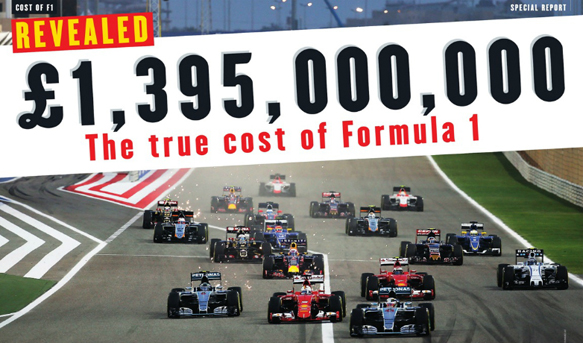
Autosport's The True Cost of F1 is now in its third edition, and therefore able to track the sport's commercial trends.
Despite increased spending at the sharp end, the overall picture continues to look bleak - since last year, a team (Caterham) has been lost, while two independents recently confirmed that they had filed official complaints with the EU Commission over the championship's controversial revenue and governance structures.
Another long-standing name - Lotus - relies predominantly on state funding provided by its Venezuelan driver, and stands on the cusp of extinction unless it is saved by Renault, while it is doubtful whether Sauber, Force India and Manor could survive without driver funding.
Indeed, only the continued largesse of Red Bull magnate Dietrich Mateschitz ensures the future of his two teams in the face of serious engine complications.
As McLaren can attest, no title partners or sponsors have come aboard, and existing sponsors are said to be negotiating further downwards off the back of dwindling live attendances and falling TV audiences - the latter having dropped 30 per cent over five years, with no end to the spiral in sight. Even the calendar has taken a knock: this year Germany failed to take up various discounted offers to host its grand prix.
However, it is not all doom and gloom: Honda rejoined the fray - as an engine supplier, again in partnership with McLaren - while next year marks the arrival of the first American team in over 30 years in machine magnate Gene Haas's eponymous operation. Therein, though, lies a stark reality: no start-up can afford F1's costs of entry without billionaire backing.
In any financially driven activity, budget and performance are symbiotic, and thus discrepancies far beyond pure technical and sporting skills or abilities are evident across the grid, with the best-funded teams mainly racing at the sharp end and budget operations generally bringing up the rear. The middle class just survives betwixt and between.
Since the beginning of 2013, Ferrari, Red Bull, McLaren and Williams have received Constructors' Championship Bonus (CCB) payments of varying sizes from commercial rights holder Formula One Management (FOM), with Mercedes receiving an increased windfall from 2016 after winning back-to-back constructors' titles. This structure further widens the gulf between rich and poor, and such payments are identified accordingly. Note: FOM monies are disbursed a year in arrears.
With eight (of 10) teams - including Red Bull Racing, McLaren, Mercedes, Williams and Force India - based in Britain, direct comparisons between UK-domiciled operations are facilitated by Companies House filings.
Such accounts are, though, at least nine months in arrears, and therefore interviews were requested across the board, and mostly granted. Where teams withheld information, educated estimates are applied. Various sources were consulted and cross-referenced, including filings, known variables, informed assumptions and inside information.
A new addition this year is a 'Bang-for-Buck' (B4B) table, whereby team budgets, excluding engine divisions, are divided by championship points scored as at the Brazilian Grand Prix to provide an efficiency index. Less is more, as they say.
Currencies have been converted from Euro (Ferrari/Toro Rosso), Swiss Francs (Sauber) and US Dollars (FOM) to Sterling for ease of comparison. Rates used: £1 = �1.35/SFr1.50/$1.50
MERCEDES
Brackley, Britain (German owned)
Full co-operation/input
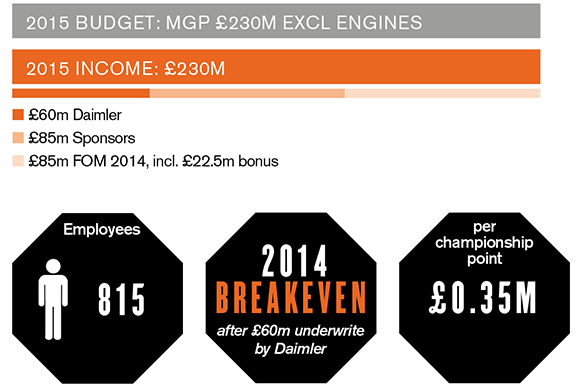
Mercedes F1's activities are split into two separate units: Mercedes Grand Prix (MGP) (race operation), and High Performance Powertrains (HPP) (self-explanatory - see separate section), which operates autonomously and supplies MGP and others. The former is held 60/30/10 by Daimler, team boss/director Toto Wolff and non-executive chairman Niki Lauda, while the latter is a 100 per cent Daimler subsidiary.
While headcount - and saliently salaries per employee - increased after last year's championship success, sponsor income and FOM revenues followed suit, with Daimler's contribution, effectively viewed as global product advertising expense by the car maker, remaining stable at £60m. However, this continuing shortfall remains a worry, potentially causing the board to reconsider its engagement over time should results go south.
Combined, Mercedes constitutes F1's largest global spend - with commensurate headcounts - yet MGP is undoubtedly the most effective B4B operation, delivering the constructors' title at £350k per point, and for around £60m direct cost. The operation is financed by a combination of Daimler funding, sponsorship, customer activities - notably Force India and other engine customers - and burgeoning FOM revenues.
Having scored consecutive double titles, MGP - already a member of F1's Strategy Group - is now a full CCB operation, therefore qualifying for additional premium payments estimated at £25m/annum from 2016. Will these be used to reduce Daimler's contribution or increase already dominant performance levels?
Motorsport director Toto Wolff: "If you see it from Daimler's perspective, it's not bad: a global advertising equivalent value of �3billion in return for its contribution."
RED BULL
Milton Keynes, Britain (Austrian owned)
Full co-operation/input

Red Bull's UK-based operation draws on two interlinked companies: Red Bull Technology (RBT), which produces cars for Racing Bull Racing (RBR), the race team management entity. RBT also provides gearboxes, hydraulics and other permitted technologies to Scuderia Toro Rosso, as well as various services to other group companies, so RBR's purified budget is £200m, on which a modest profit is expected.
RBR, however, drops to fourth in the overall classification this season, precipitating an estimated reduction of £10m (for 2016) in FOM revenues. This is, though, partially offset by lower driver retainers after Sebastian Vettel's move to Ferrari and commensurately reduced performance bonuses, while a number of contractors have been appointed to staff positions - inflating payroll, but decreasing overall outsourcing costs.
The racing team's objective remains to reduce dependence on its parent company - ultimately achieving revenue-neutrality - while continuing to generate global brand exposure for the core product through successful campaigns. However, the evident downscaling of Adrian Newey's activities, the uncertain engine situation and reducing FOM revenues will prove challenging.
Team principal Christian Horner: "We've enjoyed a stable sponsor platform, and through tight cost controls have been able to post the only profit amongst British teams in 2014 despite our drop-off in performance."
WILLIAMS
Wantage, Britain (Frankfurt Stock Exchange Listed)
Full co-operation/input
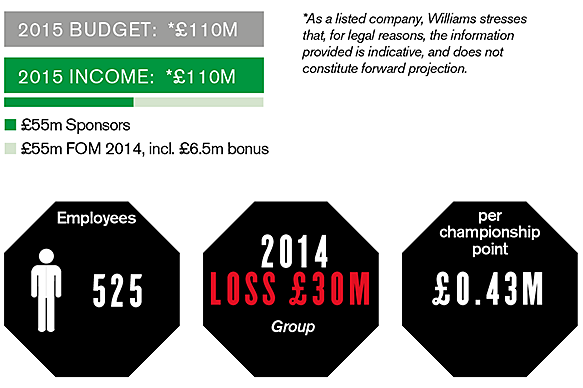
Williams Grand Prix Engineering (WGPE) moved back to the sharp end after totally reinventing itself - in the process snaring Mercedes power - and it certainly paid off on the scoreboard and balance sheet over the past two seasons. WGPE has a unique business model, being F1's only listed team.
The founder Sir Frank Williams retains 52 per cent of stock, US investor Brad Hollinger has 10 per cent and newly knighted co-founder Sir Patrick Head nine per cent, while Toto Wolff (Mercedes) controls 4.9 per cent. Employee funds control 2.5 per cent, with the balance (21.6) being publicly traded on Frankfurt's Stock Exchange.
Having moved away from driver-related funding, Williams has two revenue streams: sponsors and FOM revenues, with the arrival of Unilever and BT contributing to a 50/50 split that is both unique and a lesson to other teams, while Williams Advanced Engineering - a separate business unit - benefits from technical spins-offs and provides a commercial cushion.
Chief executive officer Mike O'Driscoll: "The team's been very lucky - all the work we put in last year is paying off, and obviously that has knock-on effects on commercial discussions as we reach the mid-point of our five-year plan."
FERRARI
Maranello, Italy
Zero co-operation/input
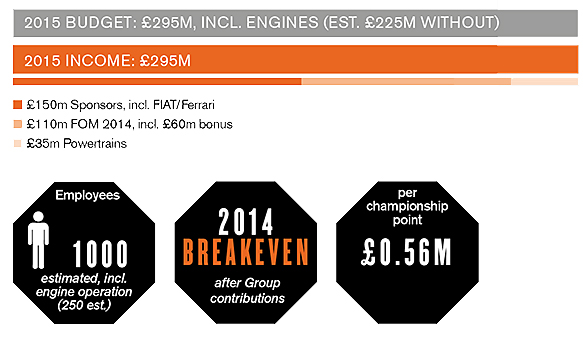
Ferrari is unique in producing an entire car within one industrial complex. It does so by sharing facilities with the road car operation, which supports Gestione Sportiva in lieu of advertising.
This complicates issues, for internal policies make accurate revenue/profit splits impossible - with October's IPO on the New York Stock Exchange serving both to obfuscate matters and divulge previously withheld information.
2015 marks the first year under a totally revised management structure - from president Sergio Marchionne, who committed increased budgets, down - but the new arrivals, particularly team boss Maurizio Arrivabene and quadruple champion Vettel, have largely rejuvenated the team, with the Scuderia now confirmed runner-up in the championship.
This will provide increased FOM revenues, of which Ferrari is already, at £110m, the primary beneficiary, further bolstering the war chest of the second-biggest spender in the sport. Add in that Vettel is (allegedly) cheaper than predecessor Fernando Alonso, and Ferrari clearly has more disposable income for the future.
Engines are supplied to two customers teams (three from 2016), enabling costs to be defrayed - these are reported separately to provide a purified base.
Ferrari press office: "Please understand that in view of our IPO we have to be very careful about any financial disclosures. Thus we are unable to help."
McLAREN
Woking, Britain
Input provided

How the mighty have fallen. Once regular contenders for victory and titles, McLaren's cars now battle to make it past Q1. True, this is primarily down to Honda's dire engine performance and reliability, but there's no denying internal issues play their parts. FOM's payouts and partners are, though, unforgiving, and woeful performance has caused McLaren's revenues to plummet as well as sponsors to depart - increasingly so in both instances.
The parent company has restructured itself as McLaren Technology Group, which provides salvation as profits from other activities plugged a £30m gap, while Honda has joined as both engine supplier and commercial partner - allegedly contributing £35m annually, plus engines - without which matters would look bleaker. Sources indicate that McLaren will approach Honda to address a projected £25m shortfall.
However, the continued absence of a title sponsor remains a worry, as does McLaren's serial lack of championship success - which impacts all revenue streams - with combined driver salaries being arguably the highest on the grid, even if Honda makes substantial contributions here, too. While McLaren is not yet endangered, how much longer can this situation persist?
Chief operating officer Jonathan Neale: "We're fortunate in having a technology group in which we can at least shelter for some of these difficult times. But it's not something we can sustain indefinitely."
SCUDERIA TORO ROSSO
Faenza, Italy (Austrian owned)
Full co-operation/input

Scuderia Toro Rosso (STR) exists as a finishing school for Red Bull's cadre of development drivers, and came of age with the successive elevations of Vettel, Daniel Ricciardo and Daniil Kvyat to RBR - which bodes well for current drivers Max Verstappen and Carlos Sainz Jr, both of whom are tipped to continue in 2016.
The team continues to expand its Faenza base, while recruitment of staff to service its Bicester (UK) windtunnel remains ongoing.
STR operates on a break-even basis, being funded by an expanding portfolio of external sponsors, with the balance of budget underwritten by Red Bull. STR receives substantial support from RBT, particularly now it runs identical rear-end technology to RBR.
Like sister RBR, engine unreliability has cost STR dearly, with no formally announced solution yet in place for 2016.
Team principal Franz Tost: "We continue to support all cost-saving initiatives that will enable us to further develop our young drivers."
FORCE INDIA
Silverstone, Britain (Indian owned)
Full co-operation/input

Force India's commercial portfolio consists of a balanced mix of shareholder loans, group company support, driver-linked contributions and FOM revenues. None of these components have fluctuated much since last year, so the team's performance hike - one slot up in a confirmed fifth place in the championship - is clearly down to stability and improved use of modest facilities, and an aggressive outsourcing policy.
A technical partnership with Mercedes GP, in which the team uses a full 'rear end' supplied by the reigning champion squad, has paid off handsomely in terms of speed and reliability, as has a switch to Toyota's windtunnel, reckoned by most to be the best in the business.
A further boost is that both drivers have been confirmed for next year. Any wonder the team is targeting a future third-place constructors' finish.
Deputy team principal Robert Fernley: "The biggest thing is the transition from our windtunnel to Toyota's exclusively, and we continue trying to maintain an optimum balance between production and outsourcing of major items."
LOTUS
Witney, Britain (Luxembourg owned)
Full co-operation/input

Beleaguered Lotus needs to secure a big-daddy investor PDQ, with Renault the most likely - if not certain - suitor. The team floats uncomfortably in that middle ground between majors and independents, carrying large-team overheads on modest income streams, yet without CCB safety nets.
Having previously downsized, there is little fat left to cut, and hence a string of energy-consuming and reputation-battering debtor actions that debilitated this once-proud operation.
Following eighth in the 2014 classification, mainly due to Renault's underperformance, both sponsor income and FOM revenue have taken knocks, depleting already thin budgets.
Mercedes power has redressed the performance deficit, but commercially the team is way off where it deserves to be and relies on Pastor Maldonado's PDVSA contribution, so remains vulnerable.
Chief executive officer Matthew Carter: "From a huge loss in 2013 we recorded a modest loss in 2014, and with our improved performance are targeting sixth place overall and improved fortunes going forward."
MANOR
Banbury, Britain
Full co-operation/input
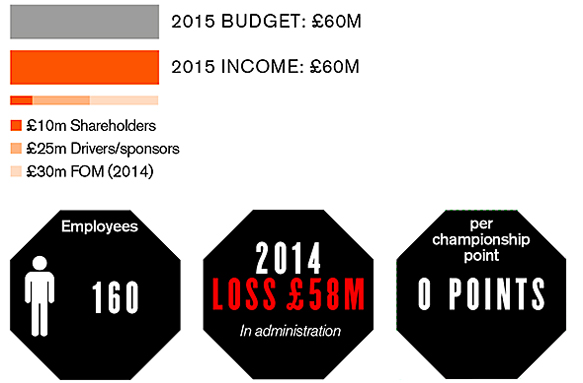
Having exited administration, Manor regrouped after attracting the support of Stephen Fitzpatrick, an energy entrepreneur. Key to the team's survival are its FOM revenues - secured via a top-10 placing in 2014 - which guarantee £30m per annum for the next two years, with drivers and a variety of sponsors contributing to the budget required to run 2014 cars powered by year-old Ferrari powertrains.
Next season should provide an upswing if plans reach fruition: Mercedes units will power Manor's new cars, while restructuring will bring new senior faces aboard. Still, it will be tough going...
President Graeme Lowdon: "This has been a pretty difficult season, but that's secondary to the fact that the team continues and that's the most important thing."
SAUBER
Hinwil, Switzerland
Full co-operation/input
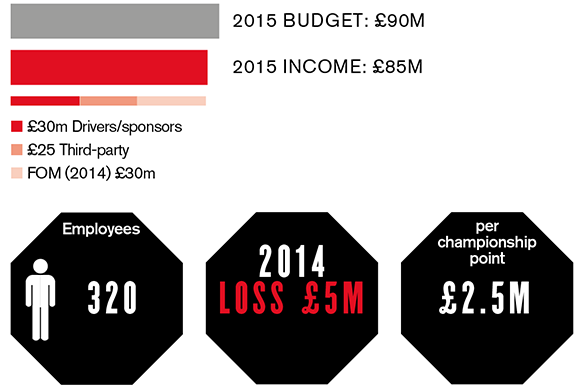
Sauber swims mid-stream. Unlike its peers, however, it is disadvantaged by invoicing in US$ but trading in buoyant Swiss Francs. This disparity, compounded by FOM's inequitable revenue structure and its lack of points in 2014, lies at the root of its current travails.
However, two well funded (and capable) drivers have led an upsurge in results, and the future is rosier, if not yet bright.
Sauber's state-of-art facilities are its salvation, being rented out to supplement budgets. The balance of funding is made up of a mix of team sponsorship, driver contributions and FOM monies.
Team principal Monisha Kaltenborn: "We have consolidated our partnerships and strengthened our third-party business, but in this environment it remains a permanent challenge."
MERCEDES GETS MOST BANG FOR ITS BUCK
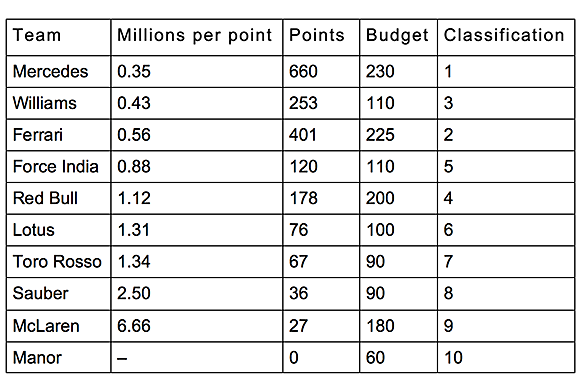
Points as of 2015 Brazilian GP. Budget does not include engines
In addition to dominating both championships, as expected, Mercedes wins Autosport's inaugural bang-for-buck Efficiency Index hands-down with a per-point spend of £0.35m/point, while Williams excelled itself to place second despite having only the fifth-largest budget.
Third, as expected, is Ferrari, with Force India doing a superb job on limited resource to place fourth. Fifth is Red Bull Racing after another fraught year.
Not only is McLaren's on-track performance disappointing, but it brings up the rear of the scorers with a per-point spend almost 20 times that of the champion team, while point-less Manor has the worst ratio.
It will be interesting to see where Haas F1, with its unique model of outsourcing where permitted, slots in next year.
In addition to detailing the index, the analysis provides a vital pointer: the total spent by all 10 teams during the 2015 season amounts to £1.395bn, or an average of £140m each.
Only four teams are above the median - Constructors' Championship Bonus teams all crucially enjoying premium payments - while the rest survive on FOM's scraps. Is it any wonder F1's revenue structure is heading for the EU Commission?
Equally, of the teams' £1.4bn spend, just £588m (42 per cent) was derived from FOM, with the balance generated by commercial sources. Yet, F1's commercial rights holder pockets around £300m from all its streams, or more than even the championship-winning team spent on its entire campaign.
F1's MONEY (POWER)TRAIN
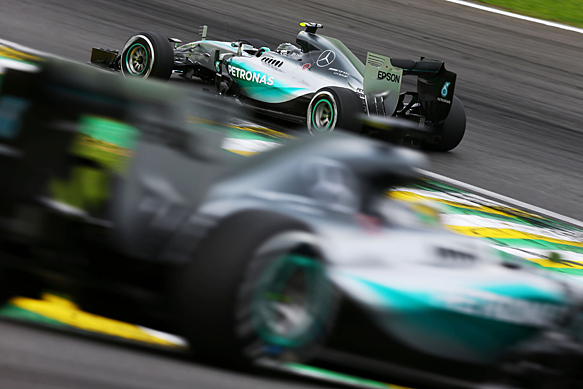
Formula 1 currently has four engine suppliers, but there are effectively only two providers of customer units - Mercedes and Ferrari - with the other two concentrating, whether by design or circumstance, on dedicated operations: Renault supplies both Red Bull teams, and Honda partners only McLaren.
Each supplier operates to its own business model, with Mercedes-Benz High Performance Powertrains being a 100 per cent subsidiary of Daimler AG, and additionally undertaking research projects on behalf of various group companies, while Ferrari's F1 engine operation operates side-by-side with both the Scuderia and the road car engine division.
Renault Sport F1 in Viry-Chatillon is, after last year's corporate restructure, a sub-division within the mother company's Renault Sport division - and operates mainly on a sub-contractor basis with suppliers. Honda operates its F1 programme as an R&D project, funded in co-operation with Honda Motor Company's marketing division, with project management jointly in the hands of R&D, Marketing and McLaren.
All four engine suppliers operate under disparate national and corporate financial reporting conventions, while their operational models are also vastly different - with their levels of outsourcing varying commensurately. The same applies to engine pricing: Ferrari adjusts internally, Mercedes has fixed (subsidised) prices, whether for supply to its own team or customers, while Renault's marketing division absorbs the difference between cost and price.
Different, too, are their levels of customer activity. Mercedes supplies three teams - Williams, Force India and Lotus - in addition to its own outfit. Ferrari supplies its own team and Sauber with current-spec engines, while Manor currently laps up its 2014-spec hardware - but switches to Mercedes next year. Renault supports just the two Red Bull squad, although doubtless it wishes it had a larger customer base to defray costs.
By contrast, Honda, which supplies 'free' engines to McLaren as part of the partnership agreement, granted the team right of refusal over supplying rival teams. There also appear to be no prospective suppliers on the horizon, which could cause complications should Renault exit F1 any time soon, as has often been threatened.
As a result, the FIA recently called for expressions of interest to supply a 'dumbed-down' standard-specification engine, which will further muddy matters by either forcing down prices or attracting existing Mercedes and Ferrari customers. Is it any wonder that Ferrari recently invoked its veto against engine cost caps; and is it also any wonder that Mercedes motorsport boss Toto Wolff said the proposal "does my head in"? It appears to have been halted for now by the F1 Commission.
All these factors make direct comparisons between engine suppliers fundamentally impossible. However, in order to provide an insight into the economics of F1 engine supply, the financial statements filed by Mercedes HPP in terms of British law have been analysed, and reported in a similar format to that used for teams.
CASE STUDY: MERCEDES HIGH PERFORMANCE POWERTRAINS
Brixworth, Britain (German owned)
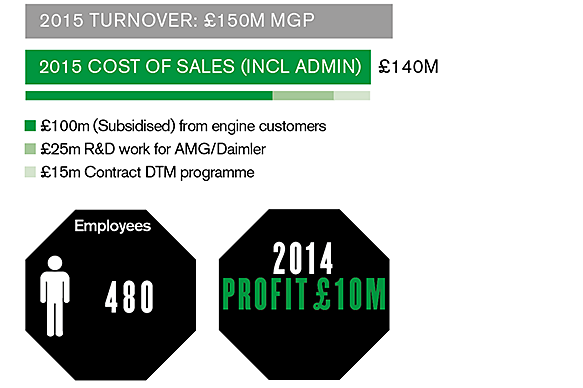
HPP, as the company is known within Mercedes, is based in Northamptonshire and previously operated as Ilmor, in which guise it contract-built Mercedes F1 and CART/IndyCar engines.
The boss is Andy Cowell, who is ultimately responsible to the board, but has a reporting line to motorsport director Toto Wolff. Directors include Niki Lauda, but, surprisingly, not Wolff.
F1 comprises approximately 75 per cent of turnover (and manpower contingent), with the company supplying four teams, including its own. 'Bare' engines are said to run to about £13m per annum per two-car team, so clearly F1 operations are indirectly subsidised to the tune of £50m annually by the mothership - given that actual recovery from teams runs to a total of £50m per season.
According to sources, the Mercedes 'own' team pays premiums for priority status on development components, but that alone would not make up the shortfall. However, this could not be verified, as such details are not disclosed in terms of exemptions received for inter-group transactions. Thus the exact breakdown of turnover is not available.
The balance of income is derived mainly via R&D for Daimler - predominantly the AMG high-performance division - and work for Mercedes' DTM programme, for which, for example, the four-cylinder engine to suit the category's new-for-2017 Class One regulations was developed in-house.
HPP chief operating officer Andy Cowell: "The directors consider quality, technical excellence, speed and flexibility, combined with cost control, to be the principal success factors towards realising the company's strategies and achieving the company's targets. Performance against these measurables is reviewed regularly."
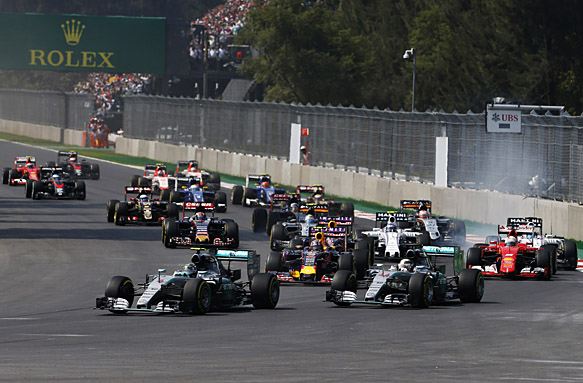
Want to know how much each grand prix team really spends? DIETER RENCKEN reveals all

Autosport's The True Cost of F1 is now in its third edition, and therefore able to track the sport's commercial trends.
Despite increased spending at the sharp end, the overall picture continues to look bleak - since last year, a team (Caterham) has been lost, while two independents recently confirmed that they had filed official complaints with the EU Commission over the championship's controversial revenue and governance structures.
Another long-standing name - Lotus - relies predominantly on state funding provided by its Venezuelan driver, and stands on the cusp of extinction unless it is saved by Renault, while it is doubtful whether Sauber, Force India and Manor could survive without driver funding.
Indeed, only the continued largesse of Red Bull magnate Dietrich Mateschitz ensures the future of his two teams in the face of serious engine complications.
As McLaren can attest, no title partners or sponsors have come aboard, and existing sponsors are said to be negotiating further downwards off the back of dwindling live attendances and falling TV audiences - the latter having dropped 30 per cent over five years, with no end to the spiral in sight. Even the calendar has taken a knock: this year Germany failed to take up various discounted offers to host its grand prix.
However, it is not all doom and gloom: Honda rejoined the fray - as an engine supplier, again in partnership with McLaren - while next year marks the arrival of the first American team in over 30 years in machine magnate Gene Haas's eponymous operation. Therein, though, lies a stark reality: no start-up can afford F1's costs of entry without billionaire backing.
In any financially driven activity, budget and performance are symbiotic, and thus discrepancies far beyond pure technical and sporting skills or abilities are evident across the grid, with the best-funded teams mainly racing at the sharp end and budget operations generally bringing up the rear. The middle class just survives betwixt and between.
Since the beginning of 2013, Ferrari, Red Bull, McLaren and Williams have received Constructors' Championship Bonus (CCB) payments of varying sizes from commercial rights holder Formula One Management (FOM), with Mercedes receiving an increased windfall from 2016 after winning back-to-back constructors' titles. This structure further widens the gulf between rich and poor, and such payments are identified accordingly. Note: FOM monies are disbursed a year in arrears.
With eight (of 10) teams - including Red Bull Racing, McLaren, Mercedes, Williams and Force India - based in Britain, direct comparisons between UK-domiciled operations are facilitated by Companies House filings.
Such accounts are, though, at least nine months in arrears, and therefore interviews were requested across the board, and mostly granted. Where teams withheld information, educated estimates are applied. Various sources were consulted and cross-referenced, including filings, known variables, informed assumptions and inside information.
A new addition this year is a 'Bang-for-Buck' (B4B) table, whereby team budgets, excluding engine divisions, are divided by championship points scored as at the Brazilian Grand Prix to provide an efficiency index. Less is more, as they say.
Currencies have been converted from Euro (Ferrari/Toro Rosso), Swiss Francs (Sauber) and US Dollars (FOM) to Sterling for ease of comparison. Rates used: £1 = �1.35/SFr1.50/$1.50
MERCEDES
Brackley, Britain (German owned)
Full co-operation/input

Mercedes F1's activities are split into two separate units: Mercedes Grand Prix (MGP) (race operation), and High Performance Powertrains (HPP) (self-explanatory - see separate section), which operates autonomously and supplies MGP and others. The former is held 60/30/10 by Daimler, team boss/director Toto Wolff and non-executive chairman Niki Lauda, while the latter is a 100 per cent Daimler subsidiary.
While headcount - and saliently salaries per employee - increased after last year's championship success, sponsor income and FOM revenues followed suit, with Daimler's contribution, effectively viewed as global product advertising expense by the car maker, remaining stable at £60m. However, this continuing shortfall remains a worry, potentially causing the board to reconsider its engagement over time should results go south.
Combined, Mercedes constitutes F1's largest global spend - with commensurate headcounts - yet MGP is undoubtedly the most effective B4B operation, delivering the constructors' title at £350k per point, and for around £60m direct cost. The operation is financed by a combination of Daimler funding, sponsorship, customer activities - notably Force India and other engine customers - and burgeoning FOM revenues.
Having scored consecutive double titles, MGP - already a member of F1's Strategy Group - is now a full CCB operation, therefore qualifying for additional premium payments estimated at £25m/annum from 2016. Will these be used to reduce Daimler's contribution or increase already dominant performance levels?
Motorsport director Toto Wolff: "If you see it from Daimler's perspective, it's not bad: a global advertising equivalent value of �3billion in return for its contribution."
RED BULL
Milton Keynes, Britain (Austrian owned)
Full co-operation/input

Red Bull's UK-based operation draws on two interlinked companies: Red Bull Technology (RBT), which produces cars for Racing Bull Racing (RBR), the race team management entity. RBT also provides gearboxes, hydraulics and other permitted technologies to Scuderia Toro Rosso, as well as various services to other group companies, so RBR's purified budget is £200m, on which a modest profit is expected.
RBR, however, drops to fourth in the overall classification this season, precipitating an estimated reduction of £10m (for 2016) in FOM revenues. This is, though, partially offset by lower driver retainers after Sebastian Vettel's move to Ferrari and commensurately reduced performance bonuses, while a number of contractors have been appointed to staff positions - inflating payroll, but decreasing overall outsourcing costs.
The racing team's objective remains to reduce dependence on its parent company - ultimately achieving revenue-neutrality - while continuing to generate global brand exposure for the core product through successful campaigns. However, the evident downscaling of Adrian Newey's activities, the uncertain engine situation and reducing FOM revenues will prove challenging.
Team principal Christian Horner: "We've enjoyed a stable sponsor platform, and through tight cost controls have been able to post the only profit amongst British teams in 2014 despite our drop-off in performance."
WILLIAMS
Wantage, Britain (Frankfurt Stock Exchange Listed)
Full co-operation/input

Williams Grand Prix Engineering (WGPE) moved back to the sharp end after totally reinventing itself - in the process snaring Mercedes power - and it certainly paid off on the scoreboard and balance sheet over the past two seasons. WGPE has a unique business model, being F1's only listed team.
The founder Sir Frank Williams retains 52 per cent of stock, US investor Brad Hollinger has 10 per cent and newly knighted co-founder Sir Patrick Head nine per cent, while Toto Wolff (Mercedes) controls 4.9 per cent. Employee funds control 2.5 per cent, with the balance (21.6) being publicly traded on Frankfurt's Stock Exchange.
Having moved away from driver-related funding, Williams has two revenue streams: sponsors and FOM revenues, with the arrival of Unilever and BT contributing to a 50/50 split that is both unique and a lesson to other teams, while Williams Advanced Engineering - a separate business unit - benefits from technical spins-offs and provides a commercial cushion.
Chief executive officer Mike O'Driscoll: "The team's been very lucky - all the work we put in last year is paying off, and obviously that has knock-on effects on commercial discussions as we reach the mid-point of our five-year plan."
FERRARI
Maranello, Italy
Zero co-operation/input

Ferrari is unique in producing an entire car within one industrial complex. It does so by sharing facilities with the road car operation, which supports Gestione Sportiva in lieu of advertising.
This complicates issues, for internal policies make accurate revenue/profit splits impossible - with October's IPO on the New York Stock Exchange serving both to obfuscate matters and divulge previously withheld information.
2015 marks the first year under a totally revised management structure - from president Sergio Marchionne, who committed increased budgets, down - but the new arrivals, particularly team boss Maurizio Arrivabene and quadruple champion Vettel, have largely rejuvenated the team, with the Scuderia now confirmed runner-up in the championship.
This will provide increased FOM revenues, of which Ferrari is already, at £110m, the primary beneficiary, further bolstering the war chest of the second-biggest spender in the sport. Add in that Vettel is (allegedly) cheaper than predecessor Fernando Alonso, and Ferrari clearly has more disposable income for the future.
Engines are supplied to two customers teams (three from 2016), enabling costs to be defrayed - these are reported separately to provide a purified base.
Ferrari press office: "Please understand that in view of our IPO we have to be very careful about any financial disclosures. Thus we are unable to help."
McLAREN
Woking, Britain
Input provided

How the mighty have fallen. Once regular contenders for victory and titles, McLaren's cars now battle to make it past Q1. True, this is primarily down to Honda's dire engine performance and reliability, but there's no denying internal issues play their parts. FOM's payouts and partners are, though, unforgiving, and woeful performance has caused McLaren's revenues to plummet as well as sponsors to depart - increasingly so in both instances.
The parent company has restructured itself as McLaren Technology Group, which provides salvation as profits from other activities plugged a £30m gap, while Honda has joined as both engine supplier and commercial partner - allegedly contributing £35m annually, plus engines - without which matters would look bleaker. Sources indicate that McLaren will approach Honda to address a projected £25m shortfall.
However, the continued absence of a title sponsor remains a worry, as does McLaren's serial lack of championship success - which impacts all revenue streams - with combined driver salaries being arguably the highest on the grid, even if Honda makes substantial contributions here, too. While McLaren is not yet endangered, how much longer can this situation persist?
Chief operating officer Jonathan Neale: "We're fortunate in having a technology group in which we can at least shelter for some of these difficult times. But it's not something we can sustain indefinitely."
SCUDERIA TORO ROSSO
Faenza, Italy (Austrian owned)
Full co-operation/input

Scuderia Toro Rosso (STR) exists as a finishing school for Red Bull's cadre of development drivers, and came of age with the successive elevations of Vettel, Daniel Ricciardo and Daniil Kvyat to RBR - which bodes well for current drivers Max Verstappen and Carlos Sainz Jr, both of whom are tipped to continue in 2016.
The team continues to expand its Faenza base, while recruitment of staff to service its Bicester (UK) windtunnel remains ongoing.
STR operates on a break-even basis, being funded by an expanding portfolio of external sponsors, with the balance of budget underwritten by Red Bull. STR receives substantial support from RBT, particularly now it runs identical rear-end technology to RBR.
Like sister RBR, engine unreliability has cost STR dearly, with no formally announced solution yet in place for 2016.
Team principal Franz Tost: "We continue to support all cost-saving initiatives that will enable us to further develop our young drivers."
FORCE INDIA
Silverstone, Britain (Indian owned)
Full co-operation/input

Force India's commercial portfolio consists of a balanced mix of shareholder loans, group company support, driver-linked contributions and FOM revenues. None of these components have fluctuated much since last year, so the team's performance hike - one slot up in a confirmed fifth place in the championship - is clearly down to stability and improved use of modest facilities, and an aggressive outsourcing policy.
A technical partnership with Mercedes GP, in which the team uses a full 'rear end' supplied by the reigning champion squad, has paid off handsomely in terms of speed and reliability, as has a switch to Toyota's windtunnel, reckoned by most to be the best in the business.
A further boost is that both drivers have been confirmed for next year. Any wonder the team is targeting a future third-place constructors' finish.
Deputy team principal Robert Fernley: "The biggest thing is the transition from our windtunnel to Toyota's exclusively, and we continue trying to maintain an optimum balance between production and outsourcing of major items."
LOTUS
Witney, Britain (Luxembourg owned)
Full co-operation/input

Beleaguered Lotus needs to secure a big-daddy investor PDQ, with Renault the most likely - if not certain - suitor. The team floats uncomfortably in that middle ground between majors and independents, carrying large-team overheads on modest income streams, yet without CCB safety nets.
Having previously downsized, there is little fat left to cut, and hence a string of energy-consuming and reputation-battering debtor actions that debilitated this once-proud operation.
Following eighth in the 2014 classification, mainly due to Renault's underperformance, both sponsor income and FOM revenue have taken knocks, depleting already thin budgets.
Mercedes power has redressed the performance deficit, but commercially the team is way off where it deserves to be and relies on Pastor Maldonado's PDVSA contribution, so remains vulnerable.
Chief executive officer Matthew Carter: "From a huge loss in 2013 we recorded a modest loss in 2014, and with our improved performance are targeting sixth place overall and improved fortunes going forward."
MANOR
Banbury, Britain
Full co-operation/input

Having exited administration, Manor regrouped after attracting the support of Stephen Fitzpatrick, an energy entrepreneur. Key to the team's survival are its FOM revenues - secured via a top-10 placing in 2014 - which guarantee £30m per annum for the next two years, with drivers and a variety of sponsors contributing to the budget required to run 2014 cars powered by year-old Ferrari powertrains.
Next season should provide an upswing if plans reach fruition: Mercedes units will power Manor's new cars, while restructuring will bring new senior faces aboard. Still, it will be tough going...
President Graeme Lowdon: "This has been a pretty difficult season, but that's secondary to the fact that the team continues and that's the most important thing."
SAUBER
Hinwil, Switzerland
Full co-operation/input

Sauber swims mid-stream. Unlike its peers, however, it is disadvantaged by invoicing in US$ but trading in buoyant Swiss Francs. This disparity, compounded by FOM's inequitable revenue structure and its lack of points in 2014, lies at the root of its current travails.
However, two well funded (and capable) drivers have led an upsurge in results, and the future is rosier, if not yet bright.
Sauber's state-of-art facilities are its salvation, being rented out to supplement budgets. The balance of funding is made up of a mix of team sponsorship, driver contributions and FOM monies.
Team principal Monisha Kaltenborn: "We have consolidated our partnerships and strengthened our third-party business, but in this environment it remains a permanent challenge."
MERCEDES GETS MOST BANG FOR ITS BUCK

Points as of 2015 Brazilian GP. Budget does not include engines
In addition to dominating both championships, as expected, Mercedes wins Autosport's inaugural bang-for-buck Efficiency Index hands-down with a per-point spend of £0.35m/point, while Williams excelled itself to place second despite having only the fifth-largest budget.
Third, as expected, is Ferrari, with Force India doing a superb job on limited resource to place fourth. Fifth is Red Bull Racing after another fraught year.
Not only is McLaren's on-track performance disappointing, but it brings up the rear of the scorers with a per-point spend almost 20 times that of the champion team, while point-less Manor has the worst ratio.
It will be interesting to see where Haas F1, with its unique model of outsourcing where permitted, slots in next year.
In addition to detailing the index, the analysis provides a vital pointer: the total spent by all 10 teams during the 2015 season amounts to £1.395bn, or an average of £140m each.
Only four teams are above the median - Constructors' Championship Bonus teams all crucially enjoying premium payments - while the rest survive on FOM's scraps. Is it any wonder F1's revenue structure is heading for the EU Commission?
Equally, of the teams' £1.4bn spend, just £588m (42 per cent) was derived from FOM, with the balance generated by commercial sources. Yet, F1's commercial rights holder pockets around £300m from all its streams, or more than even the championship-winning team spent on its entire campaign.
F1's MONEY (POWER)TRAIN

Formula 1 currently has four engine suppliers, but there are effectively only two providers of customer units - Mercedes and Ferrari - with the other two concentrating, whether by design or circumstance, on dedicated operations: Renault supplies both Red Bull teams, and Honda partners only McLaren.
Each supplier operates to its own business model, with Mercedes-Benz High Performance Powertrains being a 100 per cent subsidiary of Daimler AG, and additionally undertaking research projects on behalf of various group companies, while Ferrari's F1 engine operation operates side-by-side with both the Scuderia and the road car engine division.
Renault Sport F1 in Viry-Chatillon is, after last year's corporate restructure, a sub-division within the mother company's Renault Sport division - and operates mainly on a sub-contractor basis with suppliers. Honda operates its F1 programme as an R&D project, funded in co-operation with Honda Motor Company's marketing division, with project management jointly in the hands of R&D, Marketing and McLaren.
All four engine suppliers operate under disparate national and corporate financial reporting conventions, while their operational models are also vastly different - with their levels of outsourcing varying commensurately. The same applies to engine pricing: Ferrari adjusts internally, Mercedes has fixed (subsidised) prices, whether for supply to its own team or customers, while Renault's marketing division absorbs the difference between cost and price.
Different, too, are their levels of customer activity. Mercedes supplies three teams - Williams, Force India and Lotus - in addition to its own outfit. Ferrari supplies its own team and Sauber with current-spec engines, while Manor currently laps up its 2014-spec hardware - but switches to Mercedes next year. Renault supports just the two Red Bull squad, although doubtless it wishes it had a larger customer base to defray costs.
By contrast, Honda, which supplies 'free' engines to McLaren as part of the partnership agreement, granted the team right of refusal over supplying rival teams. There also appear to be no prospective suppliers on the horizon, which could cause complications should Renault exit F1 any time soon, as has often been threatened.
As a result, the FIA recently called for expressions of interest to supply a 'dumbed-down' standard-specification engine, which will further muddy matters by either forcing down prices or attracting existing Mercedes and Ferrari customers. Is it any wonder that Ferrari recently invoked its veto against engine cost caps; and is it also any wonder that Mercedes motorsport boss Toto Wolff said the proposal "does my head in"? It appears to have been halted for now by the F1 Commission.
All these factors make direct comparisons between engine suppliers fundamentally impossible. However, in order to provide an insight into the economics of F1 engine supply, the financial statements filed by Mercedes HPP in terms of British law have been analysed, and reported in a similar format to that used for teams.
CASE STUDY: MERCEDES HIGH PERFORMANCE POWERTRAINS
Brixworth, Britain (German owned)

HPP, as the company is known within Mercedes, is based in Northamptonshire and previously operated as Ilmor, in which guise it contract-built Mercedes F1 and CART/IndyCar engines.
The boss is Andy Cowell, who is ultimately responsible to the board, but has a reporting line to motorsport director Toto Wolff. Directors include Niki Lauda, but, surprisingly, not Wolff.
F1 comprises approximately 75 per cent of turnover (and manpower contingent), with the company supplying four teams, including its own. 'Bare' engines are said to run to about £13m per annum per two-car team, so clearly F1 operations are indirectly subsidised to the tune of £50m annually by the mothership - given that actual recovery from teams runs to a total of £50m per season.
According to sources, the Mercedes 'own' team pays premiums for priority status on development components, but that alone would not make up the shortfall. However, this could not be verified, as such details are not disclosed in terms of exemptions received for inter-group transactions. Thus the exact breakdown of turnover is not available.
The balance of income is derived mainly via R&D for Daimler - predominantly the AMG high-performance division - and work for Mercedes' DTM programme, for which, for example, the four-cylinder engine to suit the category's new-for-2017 Class One regulations was developed in-house.
HPP chief operating officer Andy Cowell: "The directors consider quality, technical excellence, speed and flexibility, combined with cost control, to be the principal success factors towards realising the company's strategies and achieving the company's targets. Performance against these measurables is reviewed regularly."

| |
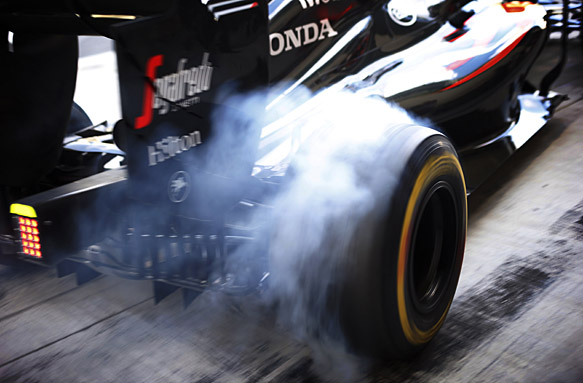
From the time the 2015 Formula 1 season finished on Sunday, and teams completed the Pirelli tyre test, the start of '16 pre-season testing was just 11 weeks away. With time now short, some teams brought 2016 developments to Abu Dhabi for track testing in first practice on the Friday of the grand prix weekend. The aim is to gather valuable data to help with their programmes over the winter.
MERCEDES
Two significant developments were clear at Mercedes: a revised suspension system and a new rear wing aero trick.
SUSPENSION
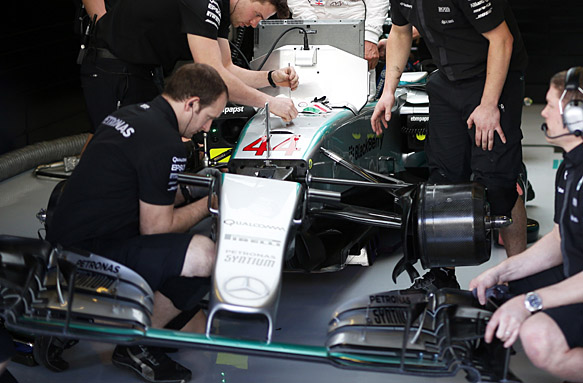
The suspension change affects the front inboard set up. This was apparently first tested on Hamilton's car as part of the S-duct setup in Brazil. It appears the car now has a single hydraulic heave damper supporting the front suspension, rather than the two separate coil sprung and hydraulic elements run previously on the W06.
It's a popular misconception that since front-and-rear interconnected suspension (FRIC) was banned last year, hydraulic suspension elements had no place in F1 either. The reality is that teams retained the hydraulic systems, but merely disconnected the front-to-rear link.
Lessons learned from how a hydraulic element can be of benefit were found to be equally useful even without the link. Therefore teams have continued to evolve ever-more complex hydraulic setups, to control both heave and roll motions. With this the race engineer can have better control of all the suspension modes.
All season Mercedes has had a simple coil-sprung device, known as the 'front coil heave unit', fitted between the pushrod rockers. This unit is visible through the aperture in the top of the chassis. Less well known was a separate hydraulic element, known internally as the 'front gas heave unit', mounted below it.
This second unit is the one that provides the Mercedes with such excellent suspension control, noticeable from the onboard shots when the car barely pitches under braking, but still moves quite freely over kerbs and in roll.
So with a hydraulic system already in place, the Brazil/Abu Dhabi set-up is more a simplification of the system. The hydraulic unit now sits higher in the tub's open hatch, with the coil unit deleted.
The car will still require a sprung mechanism to support its weight, but this can be achieved with torsion bars, or more likely a separate unit in the sidepod.
A benefit of hydraulic units over simple springs is that they can be positioned in such a way as to clear up space inside the footwell, so a remote heave spring in the sidepod is a possibility on the Merc.
With this new suspension layout and the S-duct panel, we can surmise that the 2016 car will have a very different shape at the front of the monocoque, and that the volume freed up by the new inboard suspension will be given over to the S-duct routing.
REAR WING TWEAK

Also on the Mercedes this weekend was a detail on the rear wing, where a serrated strip was attached to the rear face of the flap.
We have already seen serrated details on the Mercedes under the front wing. This design is what's known as a 'trip strip', common in aviation, to keep airflow attached to curved surfaces.
On the rear wing the strip was applied part way up the underside of the flap. This is an area where the airflow is in transition from smooth to turbulent.
The strip would appear to induce more turbulence, but in a controlled manner, as each serration creates tiny vortices. This should help make the airflow more predictable, and aid particularly in reattaching the airflow when DRS closes the wing flap.
In some respects this sort of airflow aid is similar to a 'monkey seat', not adding downforce directly but helping the air to flow as it should.
It has been suggested the strip will create a dirtier wake for following cars. While there will be more turbulence, this is at a low level and is unlikely to be felt by a following car.
McLAREN

Still working hard to understand the direction for its 2016 car, McLaren brought yet more updates to the recalcitrant MP4-30 for Abu Dhabi.
Again the work is centred on getting more rake angle put into the car's set-up. This time the rear suspension has been modified to make it all work. The team also ran a modified steering wheel, seen earlier this year.
Part of the car's early design was to retain the rear suspension fairing from 2014, but this compromised the car's rear wishbone layout since the legs needed to sit over the top of the diffuser - necessitating an unusual position for the lower wishbone, which (uniquely) sits behind the driveshaft.
Wanting a more conventional positioning of the wishbone for aerodynamic benefit is costly. The gearbox has to be redesigned to create a mounting point strong enough to accept the loads.
It appears this is the route McLaren has taken. The lower wishbone mounts at the same place at the back of the rear crash structure, but the forward leg now reaches forwards to the gearbox, creating a very wide "V" shaped arm.
With this experience, no doubt McLaren will have a more conventional rear suspension set-up for 2016.
LOTUS
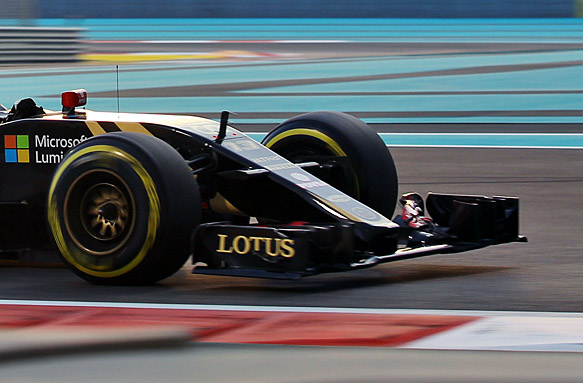
Still without certainty for its future, which has hindered development work over the second half of the season, Lotus made an unexpected development step by bringing a new nose to Abu Dhabi.
Most similar to Mercedes, Lotus has a streamlined and narrow nose, towards the limit of how short it can be.
The new nose follows a similar path, but the tip is a thumb-like design, rather than rounded. The belly of the nose at first appears to be bulbous, but it is more likely to be the front wing pylons extending rearwards into a pair of vanes, ideas commonly adopted by 'Team Enstone' in 2009, '10 and again with last year's twin-tusk design.
Although the overall dimensions of the nose are similar to the previous E23 set-up, it is in fact a totally new structure, requiring crash tests in order to be used on track.
This is a significant investment and does perhaps suggest the team's future is now a little more certain.
FORCE INDIA
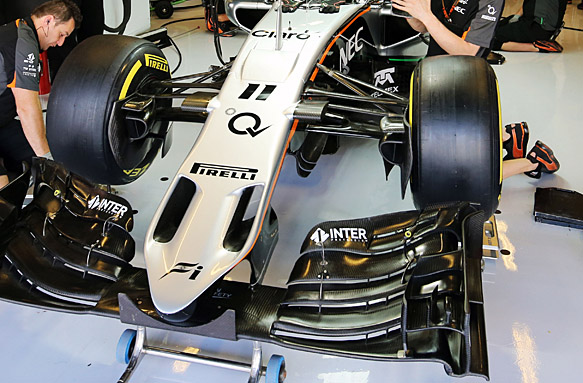
Since the team is operating with a selection of three basic front-wing designs, some observers mistakenly concluded it had brought a new wing to Abu Dhabi.
However, one of the wings was set-up with small pods on the endplate. These were not aerodynamic parts, but covers for laser rideheight sensors.
Several teams have used these sensor pods in recent years. The idea is that the wing's attitude to the track can be mapped, since the gap to the ground is a critical part of making front wings work.
| |

From the time the 2015 Formula 1 season finished on Sunday, and teams completed the Pirelli tyre test, the start of '16 pre-season testing was just 11 weeks away. With time now short, some teams brought 2016 developments to Abu Dhabi for track testing in first practice on the Friday of the grand prix weekend. The aim is to gather valuable data to help with their programmes over the winter.
MERCEDES
Two significant developments were clear at Mercedes: a revised suspension system and a new rear wing aero trick.
SUSPENSION

The suspension change affects the front inboard set up. This was apparently first tested on Hamilton's car as part of the S-duct setup in Brazil. It appears the car now has a single hydraulic heave damper supporting the front suspension, rather than the two separate coil sprung and hydraulic elements run previously on the W06.
It's a popular misconception that since front-and-rear interconnected suspension (FRIC) was banned last year, hydraulic suspension elements had no place in F1 either. The reality is that teams retained the hydraulic systems, but merely disconnected the front-to-rear link.
Lessons learned from how a hydraulic element can be of benefit were found to be equally useful even without the link. Therefore teams have continued to evolve ever-more complex hydraulic setups, to control both heave and roll motions. With this the race engineer can have better control of all the suspension modes.
All season Mercedes has had a simple coil-sprung device, known as the 'front coil heave unit', fitted between the pushrod rockers. This unit is visible through the aperture in the top of the chassis. Less well known was a separate hydraulic element, known internally as the 'front gas heave unit', mounted below it.
This second unit is the one that provides the Mercedes with such excellent suspension control, noticeable from the onboard shots when the car barely pitches under braking, but still moves quite freely over kerbs and in roll.
So with a hydraulic system already in place, the Brazil/Abu Dhabi set-up is more a simplification of the system. The hydraulic unit now sits higher in the tub's open hatch, with the coil unit deleted.
The car will still require a sprung mechanism to support its weight, but this can be achieved with torsion bars, or more likely a separate unit in the sidepod.
A benefit of hydraulic units over simple springs is that they can be positioned in such a way as to clear up space inside the footwell, so a remote heave spring in the sidepod is a possibility on the Merc.
With this new suspension layout and the S-duct panel, we can surmise that the 2016 car will have a very different shape at the front of the monocoque, and that the volume freed up by the new inboard suspension will be given over to the S-duct routing.
REAR WING TWEAK

Also on the Mercedes this weekend was a detail on the rear wing, where a serrated strip was attached to the rear face of the flap.
We have already seen serrated details on the Mercedes under the front wing. This design is what's known as a 'trip strip', common in aviation, to keep airflow attached to curved surfaces.
On the rear wing the strip was applied part way up the underside of the flap. This is an area where the airflow is in transition from smooth to turbulent.
The strip would appear to induce more turbulence, but in a controlled manner, as each serration creates tiny vortices. This should help make the airflow more predictable, and aid particularly in reattaching the airflow when DRS closes the wing flap.
In some respects this sort of airflow aid is similar to a 'monkey seat', not adding downforce directly but helping the air to flow as it should.
It has been suggested the strip will create a dirtier wake for following cars. While there will be more turbulence, this is at a low level and is unlikely to be felt by a following car.
McLAREN

Still working hard to understand the direction for its 2016 car, McLaren brought yet more updates to the recalcitrant MP4-30 for Abu Dhabi.
Again the work is centred on getting more rake angle put into the car's set-up. This time the rear suspension has been modified to make it all work. The team also ran a modified steering wheel, seen earlier this year.
Part of the car's early design was to retain the rear suspension fairing from 2014, but this compromised the car's rear wishbone layout since the legs needed to sit over the top of the diffuser - necessitating an unusual position for the lower wishbone, which (uniquely) sits behind the driveshaft.
Wanting a more conventional positioning of the wishbone for aerodynamic benefit is costly. The gearbox has to be redesigned to create a mounting point strong enough to accept the loads.
It appears this is the route McLaren has taken. The lower wishbone mounts at the same place at the back of the rear crash structure, but the forward leg now reaches forwards to the gearbox, creating a very wide "V" shaped arm.
With this experience, no doubt McLaren will have a more conventional rear suspension set-up for 2016.
LOTUS

Still without certainty for its future, which has hindered development work over the second half of the season, Lotus made an unexpected development step by bringing a new nose to Abu Dhabi.
Most similar to Mercedes, Lotus has a streamlined and narrow nose, towards the limit of how short it can be.
The new nose follows a similar path, but the tip is a thumb-like design, rather than rounded. The belly of the nose at first appears to be bulbous, but it is more likely to be the front wing pylons extending rearwards into a pair of vanes, ideas commonly adopted by 'Team Enstone' in 2009, '10 and again with last year's twin-tusk design.
Although the overall dimensions of the nose are similar to the previous E23 set-up, it is in fact a totally new structure, requiring crash tests in order to be used on track.
This is a significant investment and does perhaps suggest the team's future is now a little more certain.
FORCE INDIA

Since the team is operating with a selection of three basic front-wing designs, some observers mistakenly concluded it had brought a new wing to Abu Dhabi.
However, one of the wings was set-up with small pods on the endplate. These were not aerodynamic parts, but covers for laser rideheight sensors.
Several teams have used these sensor pods in recent years. The idea is that the wing's attitude to the track can be mapped, since the gap to the ground is a critical part of making front wings work.
记忆1:K君算是酒吧的三号人物,除去指点江山的大老板和主要工作是陪客人喝酒解闷的女经理以外,酒吧大大小小的事情都是要归K姐管的。比如日常的进货出货,酒吧每天的开张和收摊,每一位服务员的表现都要在她眼皮子底下监督着。
然而,我却发现了她的一个小秘密。
五点多钟客人并不多,有一位常客会准时来酒吧喝两杯啤酒,虎牌的,而且还要一杯冰。风雨无阻。由于是常客,他的所有单子都不用立刻在电脑里打单。只是结账的时候为了记录在系统里,我会临时给他打两杯啤酒的单子。
这次轮到K君打单子了。两杯啤酒16块钱,收钱20,找零4块不要当小费............一切都很顺利。直到我闲的无聊瞅了眼点单记录,诶,怎么只有一杯啤酒??我明明给那位常客送了两杯啤酒呀??而且常客君交了20块,明显是按照两杯啤酒的价格付的呀??
本来想提醒下K君,但是猛然一想,还是不要去撞枪口了。很明显,这少打的一杯啤酒钱在她自己的口袋里。
8块新币,折合人民币不到50。我不知道如何评价。
记忆2:阿明在酒吧的这些服务员里面有点人民公敌的意思。论资历他可以算是第五号人物,然而论等级,其实他没什么特别的。但是他最大的爱好就是给同事挑刺,同事收桌子慢了一点,他会大声呵斥,然而自己却只在一旁看着。同事跟老顾客聊天聊久了,他会过去很不客气的支开那个同事,然后自己去和老顾客聊天。他爱抽烟,一抽就要半个小时,然而机智的他选择在周五晚上9点左右最忙的时候去抽烟,留下四五个同事手忙脚乱的点单送酒。
后来有一位May姐给我指点了阿明哥行事作风的门道了。给同事挑刺的同时,他可以树立一下本来不属于自己的权威。支开同事,自己去和老顾客聊天,他可以在顾客面前现实自己的权力。经理喜欢能留住顾客的服务员,阿明哥投其所好岂不妙哉。
至于明哥种种不友好的举动真正的意图何在我并不清楚。不过无论是阿明哥的作风还是may姐的点评都告诉我,这两个人心里都已经充满了晦涩和阴暗。
很多人都有一个误区。服务员面临的最大的压力不是顾客,反而是同行。尤其是酒吧来说,顾客简直是我们最可爱的伙伴了。第一次混酒吧的新顾客很怕出丑,所以与服务员交流的时候不敢擅自耍大牌以致闹笑话。老顾客更没有必要拿服务员撒野。
混吧老手第一次来我们店的话,可能会有一些不够友好的举动,通过鄙夷的眼神和口气来让打消自己对新环境的焦虑,同时也给自己的内心添加一份虚无的满足感。对于他们,服务员只要保持一个良好的态度,和颜悦色的耐心解释,主动去消除顾客对于新环境的不自在。说不定还能发展出一个常客呢。
然而为什么很多服务员做不到?压力所致,来自生活的压力,来自经理的压力,来自同事的压力会让一个人迷失自我,变得消极。态度极端的顾客只是个案,服务员每天接触成百上千的顾客,出一个极端并不能彻底影响一个人的性格。反而是和同行的接触会潜移默化的让自己的人性任由其同化。最终堕落成了所谓的下等贱民。
可悲,但这个恶性循环里谁能救他们呢?
----------分割线----------
按照圣母们比较讨厌的说法,这个世界有非常严格的等级制度。
服务员自然而然处在社会的底层。周围的同事没有几个受过良好的教育,前面所说的May姐是从山东来新加坡打工的,家里有一个弟弟要上高中要考大学,按照传统姐姐出来给弟弟挣学费的段子太常见了。明哥来自马来西亚槟城,还是个中泰混血儿,然而从小家庭不幸,父亲家暴给他的童年留下了巨大的阴影,扭曲的性格自然也就能追根溯源了。
但这并不能让一个人的堕落变得可以原谅。人性在出生时都是一张白纸,无善无恶,然而人在出生时就已经被家庭的阶级地位烙上了影响一生的印记。但凡有更好的出路谁能出来做服务员这样几乎没有门槛的行业呢?
众生皆苦。
记忆1:K君算是酒吧的三号人物,除去指点江山的大老板和主要工作是陪客人喝酒解闷的女经理以外,酒吧大大小小的事情都是要归K姐管的。比如日常的进货出货,酒吧每天的开张和收摊,每一位服务员的表现都要在她眼皮子底下监督着。
然而,我却发现了她的一个小秘密。
五点多钟客人并不多,有一位常客会准时来酒吧喝两杯啤酒,虎牌的,而且还要一杯冰。风雨无阻。由于是常客,他的所有单子都不用立刻在电脑里打单。只是结账的时候为了记录在系统里,我会临时给他打两杯啤酒的单子。
这次轮到K君打单子了。两杯啤酒16块钱,收钱20,找零4块不要当小费............一切都很顺利。直到我闲的无聊瞅了眼点单记录,诶,怎么只有一杯啤酒??我明明给那位常客送了两杯啤酒呀??而且常客君交了20块,明显是按照两杯啤酒的价格付的呀??
本来想提醒下K君,但是猛然一想,还是不要去撞枪口了。很明显,这少打的一杯啤酒钱在她自己的口袋里。
8块新币,折合人民币不到50。我不知道如何评价。
记忆2:阿明在酒吧的这些服务员里面有点人民公敌的意思。论资历他可以算是第五号人物,然而论等级,其实他没什么特别的。但是他最大的爱好就是给同事挑刺,同事收桌子慢了一点,他会大声呵斥,然而自己却只在一旁看着。同事跟老顾客聊天聊久了,他会过去很不客气的支开那个同事,然后自己去和老顾客聊天。他爱抽烟,一抽就要半个小时,然而机智的他选择在周五晚上9点左右最忙的时候去抽烟,留下四五个同事手忙脚乱的点单送酒。
后来有一位May姐给我指点了阿明哥行事作风的门道了。给同事挑刺的同时,他可以树立一下本来不属于自己的权威。支开同事,自己去和老顾客聊天,他可以在顾客面前现实自己的权力。经理喜欢能留住顾客的服务员,阿明哥投其所好岂不妙哉。
至于明哥种种不友好的举动真正的意图何在我并不清楚。不过无论是阿明哥的作风还是may姐的点评都告诉我,这两个人心里都已经充满了晦涩和阴暗。
很多人都有一个误区。服务员面临的最大的压力不是顾客,反而是同行。尤其是酒吧来说,顾客简直是我们最可爱的伙伴了。第一次混酒吧的新顾客很怕出丑,所以与服务员交流的时候不敢擅自耍大牌以致闹笑话。老顾客更没有必要拿服务员撒野。
混吧老手第一次来我们店的话,可能会有一些不够友好的举动,通过鄙夷的眼神和口气来让打消自己对新环境的焦虑,同时也给自己的内心添加一份虚无的满足感。对于他们,服务员只要保持一个良好的态度,和颜悦色的耐心解释,主动去消除顾客对于新环境的不自在。说不定还能发展出一个常客呢。
然而为什么很多服务员做不到?压力所致,来自生活的压力,来自经理的压力,来自同事的压力会让一个人迷失自我,变得消极。态度极端的顾客只是个案,服务员每天接触成百上千的顾客,出一个极端并不能彻底影响一个人的性格。反而是和同行的接触会潜移默化的让自己的人性任由其同化。最终堕落成了所谓的下等贱民。
可悲,但这个恶性循环里谁能救他们呢?
----------分割线----------
按照圣母们比较讨厌的说法,这个世界有非常严格的等级制度。
服务员自然而然处在社会的底层。周围的同事没有几个受过良好的教育,前面所说的May姐是从山东来新加坡打工的,家里有一个弟弟要上高中要考大学,按照传统姐姐出来给弟弟挣学费的段子太常见了。明哥来自马来西亚槟城,还是个中泰混血儿,然而从小家庭不幸,父亲家暴给他的童年留下了巨大的阴影,扭曲的性格自然也就能追根溯源了。
但这并不能让一个人的堕落变得可以原谅。人性在出生时都是一张白纸,无善无恶,然而人在出生时就已经被家庭的阶级地位烙上了影响一生的印记。但凡有更好的出路谁能出来做服务员这样几乎没有门槛的行业呢?
众生皆苦。
我现在脸上写满了内疚。
我现在脸上写满了内疚。
Workload: Contact Hours: Summer Semester: 6 x one hour lectures per week, 2 x one hour practice classes per week, 2 x one hour computer laboratory classes per week.
Semester 1 and 2: 3 x one hour lectures per week, 1 x one hour practice class per week, 1 x one hour computer laboratory class per week
Total Time Commitment: Estimated total time commitment of 120 hours
Assessment: Summer semester: Five written assignments due at weekly intervals during semester amounting to a total of up to 25 pages (10%), one 45-minute written computer laboratory test held at the end of semester (10%), and a 3-hour written examination in the examination period (80%).
Semester 1 and 2: Ten written assignments due at weekly intervals during semester amounting to a total of up to 25 pages (10%), one 45-minute written computer laboratory test held at the end of semester (10%), and a 3-hour written examination in the examination period (80%).
Lectopia Enabled: I think so (never used it).
Past exams available: Yes, >4
Textbook Recommendation: Prescribed text: Elementary Linear Algebra Applications Version (H. Anton and C. Rorres), 10th edn, Wiley, 2010. (not required). There were course notes which you are supposed to fill in during lectures available at the bookshop.
Lecturer(s): Prof Peter Forrester
Year & Semester of completion: 2011 Summer
Rating: 4 Out of 5
Your Mark/Grade: H1
Comments: This subject is mainly covering the use of matrices in many different ways. I thought it was pretty easy, although that said, I did do well in math in high school. In summer, I got 3 lectures a day for 2 days a week, and for 6 weeks. The first several lectures were quite boring, because the lecturer taught a concept and then did heaps of examples which were slightly different from one another, where you'd expect to "get" the concept on the first example (although that said, I guess not everyone is strong in math). It got better as the semester progressed.
I personally found the labs to be the most difficult part of this subject, due to the coding involved, but very little knowledge of it (apart from quite basic commands) is required for the lab test.
« Last Edit: August 07, 2014, 10:13:19 PM by gongchan »
学长写的线性代数Course Review
看完简直心酸
Workload: Contact Hours: Summer Semester: 6 x one hour lectures per week, 2 x one hour practice classes per week, 2 x one hour computer laboratory classes per week.
Semester 1 and 2: 3 x one hour lectures per week, 1 x one hour practice class per week, 1 x one hour computer laboratory class per week
Total Time Commitment: Estimated total time commitment of 120 hours
Assessment: Summer semester: Five written assignments due at weekly intervals during semester amounting to a total of up to 25 pages (10%), one 45-minute written computer laboratory test held at the end of semester (10%), and a 3-hour written examination in the examination period (80%).
Semester 1 and 2: Ten written assignments due at weekly intervals during semester amounting to a total of up to 25 pages (10%), one 45-minute written computer laboratory test held at the end of semester (10%), and a 3-hour written examination in the examination period (80%).
Lectopia Enabled: I think so (never used it).
Past exams available: Yes, >4
Textbook Recommendation: Prescribed text: Elementary Linear Algebra Applications Version (H. Anton and C. Rorres), 10th edn, Wiley, 2010. (not required). There were course notes which you are supposed to fill in during lectures available at the bookshop.
Lecturer(s): Prof Peter Forrester
Year & Semester of completion: 2011 Summer
Rating: 4 Out of 5
Your Mark/Grade: H1
Comments: This subject is mainly covering the use of matrices in many different ways. I thought it was pretty easy, although that said, I did do well in math in high school. In summer, I got 3 lectures a day for 2 days a week, and for 6 weeks. The first several lectures were quite boring, because the lecturer taught a concept and then did heaps of examples which were slightly different from one another, where you'd expect to "get" the concept on the first example (although that said, I guess not everyone is strong in math). It got better as the semester progressed.
I personally found the labs to be the most difficult part of this subject, due to the coding involved, but very little knowledge of it (apart from quite basic commands) is required for the lab test.
« Last Edit: August 07, 2014, 10:13:19 PM by gongchan »
学长写的线性代数Course Review
看完简直心酸
Q =
4 0 0 0 0 7 7 7 7 7 7 7
0 8 0 0 0 7 7 7 7 7 7 7
0 0 8 0 0 7 7 7 7 7 7 7
0 0 0 11 0 7 7 7 7 7 7 7
0 0 0 0 1 7 7 7 7 7 7 7
12 12 12 12 12 1 7 7 7 7 7 7
12 12 12 12 12 7 1 7 7 7 7 7
12 12 12 12 12 7 7 1 7 7 7 7
12 12 12 12 12 7 7 7 1 7 7 7
12 12 12 12 12 7 7 7 7 1 7 7
12 12 12 12 12 7 7 7 7 7 1 7
12 12 12 12 12 7 7 7 7 7 7 1
Q =
4 0 0 0 0 7 7 7 7 7 7 7
0 8 0 0 0 7 7 7 7 7 7 7
0 0 8 0 0 7 7 7 7 7 7 7
0 0 0 11 0 7 7 7 7 7 7 7
0 0 0 0 1 7 7 7 7 7 7 7
12 12 12 12 12 1 7 7 7 7 7 7
12 12 12 12 12 7 1 7 7 7 7 7
12 12 12 12 12 7 7 1 7 7 7 7
12 12 12 12 12 7 7 7 1 7 7 7
12 12 12 12 12 7 7 7 7 1 7 7
12 12 12 12 12 7 7 7 7 7 1 7
12 12 12 12 12 7 7 7 7 7 7 1
上海匡慧网络科技有限公司 沪B2-20211235 沪ICP备2021021198号-6 Copyright ©2021 KUANGHUI All Rights Reserved. 匡慧公司 版权所有





